French Revolution
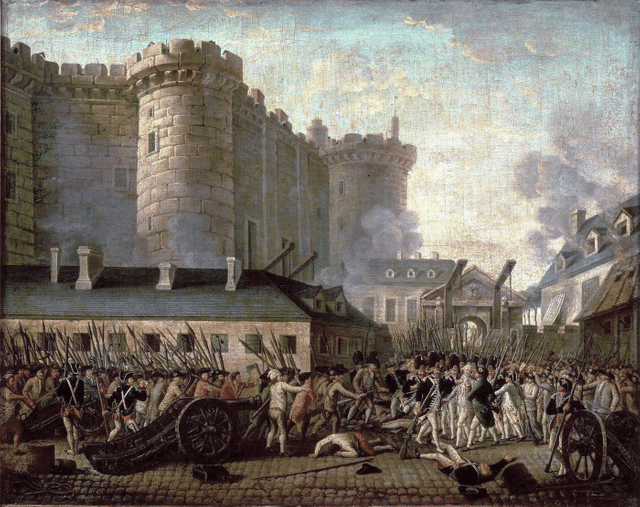
French Revolution

| Part of the Atlantic Revolutions | |
| Date | 5 May 1789 – 9 November 1799 (1789-05-05 –1799-11-09) (10 years, 6 months and 4 days) |
|---|---|
| Location | Kingdom of France |
| Outcome |
|
The French Revolution (French: Révolution française [ʁevɔlysjɔ̃ fʁɑ̃sɛːz]) was a period of far-reaching social and political upheaval in France and its colonies beginning in 1789. The Revolution overthrew the monarchy, established a republic, catalyzed violent periods of political turmoil, and finally culminated in a dictatorship under Napoleon who brought many of its principles to areas he conquered in Western Europe and beyond. Inspired by liberal and radical ideas, the Revolution profoundly altered the course of modern history, triggering the global decline of absolute monarchies while replacing them with republics and liberal democracies.[1] Through the Revolutionary Wars, it unleashed a wave of global conflicts that extended from the Caribbean to the Middle East. Historians widely regard the Revolution as one of the most important events in human history.[2][3][4]
The causes of the French Revolution are complex and are still debated among historians. Following the Seven Years' War and the American Revolutionary War,[5] the French government was deeply in debt. It attempted to restore its financial status through unpopular taxation schemes, which were heavily regressive. Leading up to the Revolution, years of bad harvests worsened by deregulation of the grain industry and environmental problems also inflamed popular resentment of the privileges enjoyed by the aristocracy and the Catholic clergy of the established church. Some historians hold something similar to what Thomas Jefferson proclaimed: that France had "been awakened by our [American] Revolution."[6] Demands for change were formulated in terms of Enlightenment ideals and contributed to the convocation of the Estates General in May 1789. During the first year of the Revolution, members of the Third Estate (commoners) took control, the Bastille was attacked in July, the Declaration of the Rights of Man and of the Citizen was passed in August, and the Women's March on Versailles forced the royal court back to Paris in October. A central event of the first stage, in August 1789, was the abolition of feudalism and the old rules and privileges left over from the Ancien Régime.
The next few years featured political struggles between various liberal assemblies and right-wing supporters of the monarchy intent on thwarting major reforms. The Republic was proclaimed in September 1792 after the French victory at Valmy. In a momentous event that led to international condemnation, Louis XVI was executed in January 1793.
External threats closely shaped the course of the Revolution. The Revolutionary Wars beginning in 1792 ultimately featured French victories that facilitated the conquest of the Italian Peninsula, the Low Countries and most territories west of the Rhine – achievements that had eluded previous French governments for centuries. Internally, popular agitation radicalised the Revolution significantly, culminating in the rise of Maximilien Robespierre and the Jacobins. The dictatorship imposed by the Committee of Public Safety during the Reign of Terror, from 1793 until 1794, established price controls on food and other items, abolished slavery in French colonies abroad, de-established the Catholic church (dechristianised society) and created a secular Republican calendar, religious leaders were expelled, and the borders of the new republic were secured from its enemies.
After the Thermidorian Reaction, an executive council known as the Directory assumed control of the French state in 1795. They suspended elections, repudiated debts (creating financial instability in the process), persecuted the Catholic clergy, and made significant military conquests abroad.[7] Dogged by charges of corruption, the Directory collapsed in a coup led by Napoleon Bonaparte in 1799. Napoleon, who became the hero of the Revolution through his popular military campaigns, established the Consulate and later the First Empire, setting the stage for a wider array of global conflicts in the Napoleonic Wars.
The modern era has unfolded in the shadow of the French Revolution. Almost all future revolutionary movements looked back to the Revolution as their predecessor.[8] Its central phrases and cultural symbols, such as La Marseillaise and Liberté, fraternité, égalité, ou la mort, became the clarion call for other major upheavals in modern history, including the Russian Revolution over a century later.[9]
The values and institutions of the Revolution dominate French politics to this day. The Revolution resulted in the suppression of the feudal system, emancipation of the individual, a greater division of landed property, abolition of the privileges of noble birth, and nominal establishment of equality among men. The French Revolution differed from other revolutions in being not only national, for it intended to benefit all humanity.[10]
Globally, the Revolution accelerated the rise of republics and democracies. It became the focal point for the development of most modern political ideologies, leading to the spread of liberalism, radicalism, nationalism, and secularism, among many others. The Revolution also witnessed the birth of total war by organising the resources of France and the lives of its citizens towards the objective of national defense.[11] Some of its central documents, such as the Declaration of the Rights of Man and of the Citizen, continued to inspire movements for abolitionism and universal suffrage in the next century.[12]
| Part of the Atlantic Revolutions | |
| Date | 5 May 1789 – 9 November 1799 (1789-05-05 –1799-11-09) (10 years, 6 months and 4 days) |
|---|---|
| Location | Kingdom of France |
| Outcome |
|
Causes
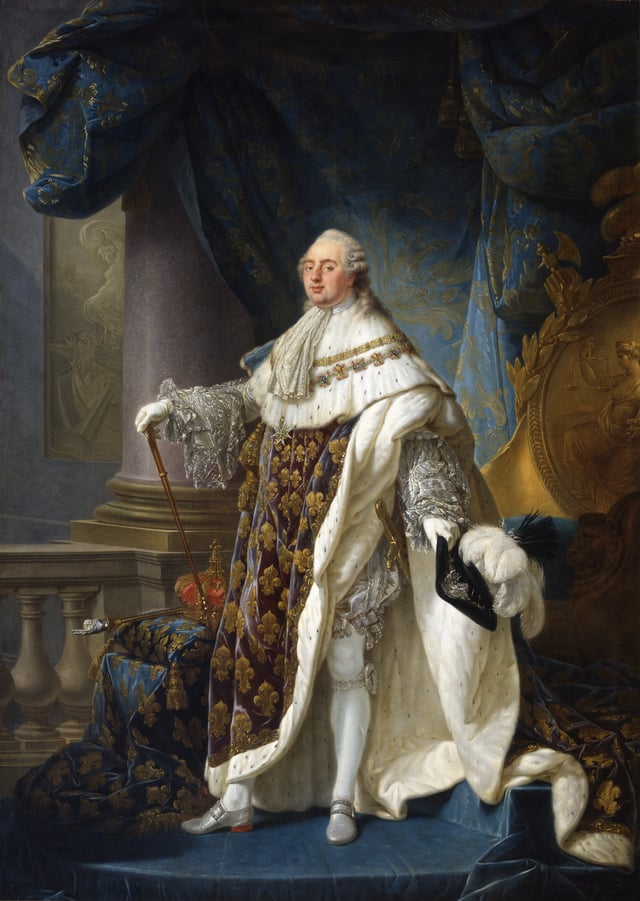
King Louis XVI's government was blamed for mishandling the fiscal crises in the 1780s.
Historians have pointed to many events and factors within the Ancien Régime that led to the Revolution. Rising social and economic inequality,[13][14] new political ideas emerging from the Enlightenment,[15] economic mismanagement, environmental factors leading to agricultural failure, unmanageable national debt,[16] and political mismanagement on the part of King Louis XVI have all been cited as laying the groundwork for the Revolution.[17][18][19][20]
Over the course of the 18th century, there emerged what the philosopher Jürgen Habermas called the idea of the "public sphere" in France and elsewhere in Europe.[21] Habermas argued that the dominant cultural model in 17th-century France was a "representational" culture, which was based on a one-sided need to "represent" power with one side active and the other passive.[21] A perfect example would be the Palace of Versailles, which was meant to overwhelm the senses of the visitor and convince one of the greatness of the French state and Louis XIV.[21] Starting in the early 18th century the "public sphere" emerged which was "critical" in that both sides were active.[22] Examples of the public sphere included newspapers, journals, masonic lodges, coffee houses and reading clubs where people either in person or virtually via the printed word debated and discussed issues.[23] In France, the emergence of the public sphere outside of the control of the state led to the shift from Versailles to Paris as the cultural capital of France.[23] Likewise, while in the 17th century the court had decided what was culturally good and what was not, in the 18th century the opinion of the court mattered less and consumers became the arbiters of cultural taste.[24] In the 1750s, during the "Querelle des Bouffons" over the question of the quality of Italian vs. French music, the partisans of both sides appealed to the French public "because it alone has the right to decide whether a work will be preserved for posterity or will be used by grocers as wrapping-paper".[25] In 1782, Louis-Sébastien Mercier wrote: "The word court no longer inspires awe amongst us as in the time of Louis XIV. Reigning opinions are no longer received from the court; it no longer decides on reputations of any sort ... The court's judgments are countermanded; one says openly that it understands nothing; it has no ideas on the subject and could have none."[26] Inevitably, the belief that public opinion had the right to decide cultural questions instead of deferring to the court transformed itself into the demand that the public also have a say on political questions as well.[27]
The economy in the Ancien Régime during the years preceding the Revolution suffered from instability. The sequence of events leading to the Revolution included the national government's fiscal troubles caused by an unjust, inefficient and deeply hated tax system – the ferme générale – and by expenditure on numerous large wars.[16] The attempt to challenge British naval and commercial power in the Seven Years' War was a costly disaster, with the loss of France's colonial possessions in continental North America and the destruction of the French Navy.[28] French forces were rebuilt, and feeling bitter about having lost many of France's overseas colonies to the British Empire during the Seven Years' War, Louis XVI was eager to give the American rebels financial and military support. After the British surrender at the Battle of Saratoga, the French sent 10,000 troops and millions of dollars to the rebels. Despite succeeding in gaining independence for the Thirteen Colonies, France was severely indebted by the American Revolutionary War. France's inefficient and antiquated financial system could not finance this debt.[29] Faced with a financial crisis, the king called an Estates General, recommended by the Assembly of Notables in 1787 for the first time in over a century.[30]
France was experiencing such a severe economic depression that there wasn't enough food to go around. Poor harvests lasting several years and an inadequate transportation system both contributed to making food more expensive.[31][32] As with most monarchies, the upper class was always ensured a stable living, so while the rich remained very wealthy, the majority of the French population was starving. Many were so destitute that they couldn't even feed their families and resorted to theft or prostitution to stay alive. Meanwhile, the royal court at Versailles was isolated from and indifferent to the escalating crisis. While in theory King Louis XVI was an absolute monarch, in practice he was often indecisive and known to back down when faced with strong opposition. While he did reduce government expenditures, opponents in the parlements successfully thwarted his attempts at enacting much needed reforms. The Enlightenment had produced many writers, pamphleteers and publishers who could inform or inflame public opinion. The opposition used this resource to mobilise public opinion against the monarchy, which in turn tried to repress the underground literature.[29]
Many other factors involved resentments and aspirations given focus by the rise of Enlightenment ideals. These included resentment of royal absolutism; resentment by peasants, labourers and the bourgeoisie towards the traditional seigneurial privileges possessed by the nobility; resentment of the Catholic Church's influence over public policy and institutions; aspirations for freedom of religion; resentment of aristocratic bishops by the poorer rural clergy; aspirations for social, political and economic equality, and (especially as the Revolution progressed) republicanism; hatred of Queen Marie-Antoinette, who was falsely accused of being a spendthrift and an Austrian spy; and anger towards the King for dismissing ministers, including finance minister Jacques Necker, who were popularly seen as representatives of the people.[33]
Ancien Régime
Financial crisis
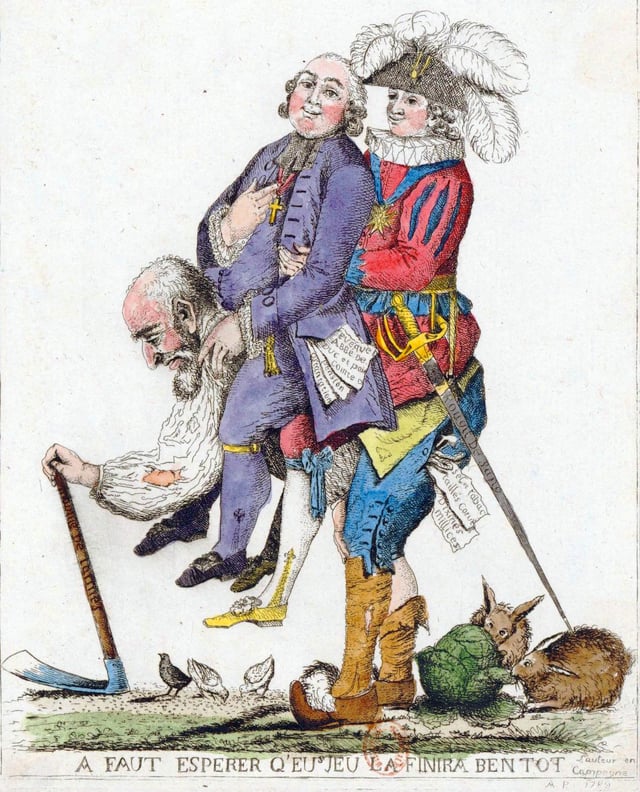
Caricature of the Third Estate carrying the First Estate (clergy) and the Second Estate (nobility) on its back
In 1774 Louis XVI ascended to the throne in the middle of a financial crisis in which the state was faced with a budget deficit and was nearing bankruptcy.[34] This was due in part to France's costly involvements in the Seven Years' War and later the American Revolutionary War.[35] In May 1776, finance minister Turgot was dismissed, after failing to enact reforms. The next year, Jacques Necker, a foreigner, was appointed Comptroller-General of Finance. He could not be made an official minister because he was a Protestant.[36]
Necker realised that the country's extremely regressive tax system subjected the lower classes to a heavy burden,[36] while numerous exemptions existed for the nobility and clergy.[37] He argued that the country could not be taxed higher; that tax exemptions for the nobility and clergy must be reduced; and proposed that borrowing more money would solve the country's fiscal shortages. Necker published a report to support this claim that underestimated the deficit by roughly 36 million livres, and proposed restricting the power of the parlements.[36]
This was not received well by the King's ministers, and Necker, hoping to bolster his position, argued to be made a minister. The King refused, Necker was dismissed, and Charles Alexandre de Calonne was appointed to the Comptrollership.[36] Calonne initially spent liberally, but he quickly realised the critical financial situation and proposed a new tax code.[38]
The proposal included a consistent land tax, which would include taxation of the nobility and clergy. Faced with opposition from the parlements, Calonne organised the summoning of the Assembly of Notables. But the Assembly failed to endorse Calonne's proposals and instead weakened his position through its criticism. In response, the King announced the calling of the Estates-General for May 1789, the first time the body had been summoned since 1614. This was a signal that the Bourbon monarchy was in a weakened state and subject to the demands of its people.[39]
Estates-General of 1789

The meeting of the Estates General on 5 May 1789 at Versailles
The Estates-General was organised into three estates: the clergy, the nobility, and the rest of France. It had last met in 1614. Elections were held in the spring of 1789; suffrage requirements for the Third Estate were for French-born or naturalised males, aged 25 years or more, who resided where the vote was to take place and who paid taxes. Strong turnout produced 1,201 delegates, including 303 clergy, 291 nobles and 610 members of the Third Estate. The First Estate represented 100,000 Catholic clergy; the Church owned about 10% of the land and collected its own taxes (the tithe) on peasants. The lands were controlled by bishops and abbots of monasteries, but two-thirds of the 303 delegates from the First Estate were ordinary parish priests; only 51 were bishops.[40] The Second Estate represented the nobility, about 400,000 men and women who owned about 25% of the land and collected seigneurial dues and rents from their peasant tenants. About a third of these deputies were nobles, mostly with minor holdings. The Third Estate representation was doubled to 610 men, representing 95% of the population. Half were well educated lawyers or local officials. Nearly a third were in trades or industry; 51 were wealthy land owners.[41][42]
To assist delegates, "Books of grievances" (cahiers de doléances) were compiled to list problems.[43] The books articulated ideas which would have seemed radical only months before; however, most supported the monarchical system in general. Many assumed the Estates-General would approve future taxes, and Enlightenment ideals were relatively rare.[44][45]
Pamphlets by liberal nobles and clergy became widespread after the lifting of press censorship.[46] The Abbé Sieyès, a theorist and Catholic clergyman, argued the paramount importance of the Third Estate in the pamphlet Qu'est-ce que le tiers état? (What is the Third Estate?) published in January 1789. He asserted: "What is the Third Estate? Everything. What has it been until now in the political order? Nothing. What does it want to be? Something."[47]
The Estates-General convened in the Grands Salles des Menus-Plaisirs in Versailles on 5 May 1789 and opened with a three-hour speech by Necker. The Third Estate demanded that the credentials of deputies should be verified by all deputies, rather than each estate verifying the credentials of its own members, but negotiations with the other estates failed to achieve this. The commoners appealed to the clergy, who asked for more time. Necker then stated that each estate should verify its own members' credentials and that the king should act as arbitrator.[48]
National Assembly (1789)
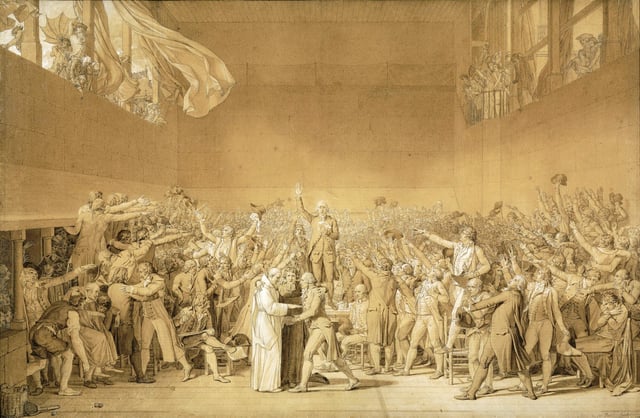
The National Assembly taking the Tennis Court Oath (sketch by Jacques-Louis David)
On 10 June 1789 Abbé Sieyès moved that the Third Estate, now meeting as the Communes (English: "Commons") proceed with verifying its own powers and invite the other two estates to take part, but not to wait for them. They proceeded to do so two days later, completing the process on 17 June.[49] Then they voted a measure far more radical, declaring themselves the National Assembly, an assembly not of the Estates but of "the People". They invited the other orders to join them, but made it clear they intended to conduct the nation's affairs with or without them.[50]
In an attempt to keep control of the process and prevent the Assembly from convening, Louis XVI ordered the closure of the Salle des États where the Assembly met, making an excuse that the carpenters needed to prepare the hall for a royal speech in two days. Weather did not allow an outdoor meeting, and fearing an attack ordered by Louis XVI, they met in a tennis court just outside Versailles, where they proceeded to swear the Tennis Court Oath (20 June 1789) under which they agreed not to separate until they had given France a constitution. A majority of the representatives of the clergy soon joined them, as did 47 members of the nobility. By 27 June, the royal party had overtly given in, although the military began to arrive in large numbers around Paris and Versailles. Messages of support for the Assembly poured in from Paris and other French cities.[51]
Constitutional monarchy
National Constituent Assembly (July 1789 – September 1791)
Storming of the Bastille

The Storming of the Bastille in July 1789 is widely regarded as the most iconic event of the Revolution.
By this time, Necker had earned the enmity of many members of the French court for his overt manipulation of public opinion. Marie Antoinette, the King's younger brother the Comte d'Artois, and other conservative members of the King's privy council urged him to dismiss Necker as financial advisor. On 11 July 1789, after Necker published an inaccurate account of the government's debts and made it available to the public, the King fired him, and completely restructured the finance ministry at the same time.[52]
Many Parisians presumed Louis' actions to be aimed against the Assembly and began open rebellion when they heard the news the next day. They were also afraid that arriving soldiers – mostly foreign mercenaries – had been summoned to shut down the National Constituent Assembly. The Assembly, meeting at Versailles, went into nonstop session to prevent another eviction from their meeting place. Paris was soon consumed by riots, chaos, and widespread looting. The mobs soon had the support of some of the French Guard, who were armed and trained soldiers.[53]
On 14 July, the insurgents set their eyes on the large weapons and ammunition cache inside the Bastille fortress, which was also perceived to be a symbol of royal power. After several hours of combat, the prison fell that afternoon. Despite ordering a ceasefire, which prevented a mutual massacre, Governor Marquis Bernard-René de Launay was beaten, stabbed and decapitated; his head was placed on a pike and paraded about the city. Although the fortress had held only seven prisoners (four forgers, two noblemen kept for immoral behaviour, and a murder suspect) the Bastille served as a potent symbol of everything hated under the Ancien Régime. Returning to the Hôtel de Ville (city hall), the mob accused the prévôt des marchands (roughly, mayor) Jacques de Flesselles of treachery and butchered him.[54]
The King, alarmed by the violence, backed down, at least for the time being. The Marquis de Lafayette took up command of the National Guard at Paris. Jean-Sylvain Bailly, president of the Assembly at the time of the Tennis Court Oath, became the city's mayor under a new governmental structure known as the commune. The King visited Paris, where, on 17 July he accepted a tricolore cockade, to cries of Vive la Nation ("Long live the Nation") and Vive le Roi ("Long live the King").[55]
Necker was recalled to power, but his triumph was short-lived. An astute financier but a less astute politician, Necker overplayed his hand by demanding and obtaining a general amnesty, losing much of the people's favour.
As civil authority rapidly deteriorated, with random acts of violence and theft breaking out across the country, members of the nobility, fearing for their safety, fled to neighbouring countries; many of these émigrés, as they were called, funded counter-revolutionary causes within France and urged foreign monarchs to offer military support to a counter-revolution.[56]
By late July, the spirit of popular sovereignty had spread throughout France. In rural areas, many commoners began to form militias and arm themselves against a foreign invasion: some attacked the châteaux of the nobility as part of a general agrarian insurrection known as "la Grande Peur" ("the Great Fear"). In addition, wild rumours and paranoia caused widespread unrest and civil disturbances that contributed to the collapse of law and order.[57]
Abolition of feudalism
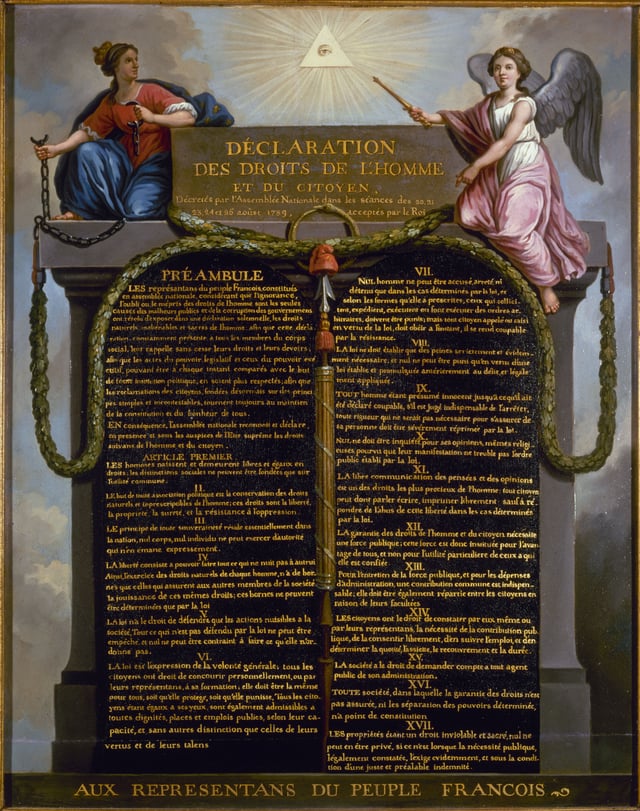
The Declaration of the Rights of Man and of the Citizen of 26 August 1789
On 4 and 11 August 1789 the National Constituent Assembly abolished privileges and feudalism (numerous peasant revolts had almost brought feudalism to an end) in the August Decrees, sweeping away personal serfdom,[58] exclusive hunting rights and other seigneurial rights of the Second Estate (nobility).
Historian Georges Lefebvre summarises the night's work:
"Without debate the Assembly enthusiastically adopted equality of taxation and redemption of all manorial rights except for those involving personal servitude – which were to be abolished without indemnification. Other proposals followed with the same success: the equality of legal punishment, admission of all to public office, abolition of venality in office,[61] conversion of the tithe into payments subject to redemption, freedom of worship, prohibition of plural holding of benefices ... Privileges of provinces and towns were offered as a last sacrifice."[62]
Originally the peasants were supposed to pay for the release of seigneurial dues; these dues affected more than a fourth of the farmland in France and provided most of the income of the large landowners.[63] The majority refused to pay and in 1793 the obligation was cancelled. Thus the peasants got their land free, and also no longer paid the tithe to the church.[64]
Furet emphasises that the decisions of August 1789 survived and became an integral part of
"the founding texts of modern France. They destroyed aristocratic society from top to bottom, along with its structure of dependencies and privileges. For this structure they substituted the modern, autonomous individual, free to do whatever was not prohibited by law ... The Revolution thus distinguished itself quite early by its radical individualism"[65]
The old judicial system, based on the 13 regional parlements, was suspended in November 1789, and officially abolished in September 1790. The main institutional pillars of the old regime had vanished.[66]
Declaration of the Rights of Man
On 26 August 1789 the Assembly published the Declaration of the Rights of Man and of the Citizen, which comprised a statement of principles rather than a constitution with legal effect. The Declaration was directly influenced by Thomas Jefferson working with General Lafayette, who introduced it.[67]
The National Constituent Assembly functioned not only as a legislature, but also as a body to draft a new constitution.
Writing the first constitution
Necker, Mounier, Lally-Tollendal and others argued unsuccessfully for a senate, with members appointed by the crown on the nomination of the people. The bulk of the nobles argued for an aristocratic upper house elected by the nobles. The popular party carried the day: France would have a single, unicameral assembly. The King retained only a "suspensive veto"; he could delay the implementation of a law, but not block it absolutely. The Assembly eventually replaced the historic provinces with 83 départements, uniformly administered and roughly equal in area and population.[66]
Amid the Assembly's preoccupation with constitutional affairs, the financial crisis had continued largely unaddressed, and the deficit had only increased. Honoré Mirabeau now led the move to address this matter, and the Assembly gave Necker complete financial dictatorship.
Women's March on Versailles

Engraving of the Women's March on Versailles, 5 October 1789
Fuelled by rumours of a reception for the King's bodyguards on 1 October 1789, at which the national cockade had been trampled upon, on 5 October 1789, crowds of women began to assemble at Parisian markets. The women first marched to the Hôtel de Ville, demanding that city officials address their concerns.[68] The women were responding to the harsh economic situations they faced, especially bread shortages. They also demanded an end to royal efforts to block the National Assembly, and for the King and his administration to move to Paris as a sign of good faith in addressing the widespread poverty.
Getting unsatisfactory responses from city officials, as many as 7,000 women joined the march to Versailles, bringing with them cannons and a variety of smaller weapons. Twenty thousand National Guardsmen under the command of Lafayette responded to keep order, and members of the mob stormed the palace, killing several guards.[69] Lafayette ultimately persuaded the king to accede to the demand of the crowd that the monarchy relocate to Paris.
On 6 October 1789, the King and the royal family moved from Versailles to Paris under the "protection" of the National Guards, thus legitimising the National Assembly.
Revolution and the Church
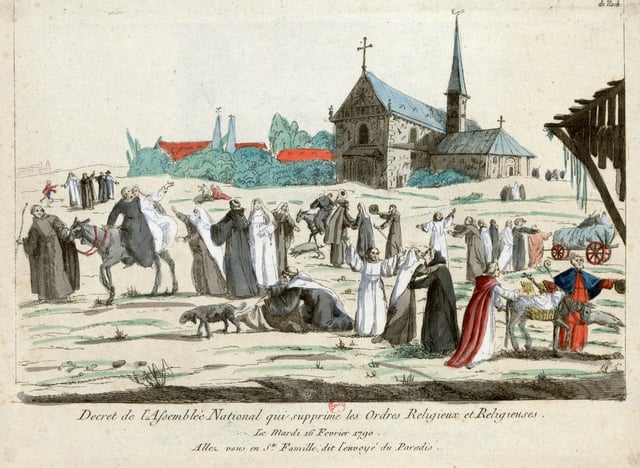
In this caricature, monks and nuns enjoy their new freedom after the decree of 16 February 1790.
The Revolution caused a massive shift of power from the Roman Catholic Church to the state.[70] Under the Ancien Régime, the Church had been the largest single landowner in the country, owning about 10% of the land in the kingdom.[71] The Church was exempt from paying taxes to the government, while it levied a tithe – a 10% tax on income, often collected in the form of crops – on the general population, only a fraction of which it then redistributed to the poor.[71]
Resentment towards the Church weakened its power during the opening of the Estates General in May 1789. The Church composed the First Estate with 130,000 members of the clergy. When the National Assembly was later created in June 1789 by the Third Estate, the clergy voted to join them, which perpetuated the destruction of the Estates General as a governing body.[72] The National Assembly began to enact social and economic reform. Legislation sanctioned on 4 August 1789 abolished the Church's authority to impose the tithe. In an attempt to address the financial crisis, the Assembly declared, on 2 November 1789, that the property of the Church was "at the disposal of the nation".[73] They used this property to back a new currency, the assignats. Thus, the nation had now also taken on the responsibility of the Church, which included paying the clergy and caring for the poor, the sick and the orphaned.[74] In December, the Assembly began to sell the lands to the highest bidder to raise revenue, effectively decreasing the value of the assignats by 25% in two years.[75] In autumn 1789, legislation abolished monastic vows and on 13 February 1790 all religious orders were dissolved.[76] Monks and nuns were encouraged to return to private life and a small percentage did eventually marry.[77]
The Civil Constitution of the Clergy, passed on 12 July 1790, turned the remaining clergy into employees of the state. This established an election system for parish priests and bishops and set a pay rate for the clergy. Many Catholics objected to the election system because it effectively denied the authority of the Pope in Rome over the French Church. In October a group of 30 bishops wrote a declaration saying they could not accept that law, and this protest fueled also civilian opposition against that law.[59] Eventually, in November 1790, the National Assembly began to require an oath of loyalty to the Civil Constitution from all the members of the clergy.[77] This led to a schism between those clergy who swore the required oath and accepted the new arrangement and those who remained loyal to the Pope. Priests swearing the oath were indicated as 'constitutional', those not taking the oath as 'non-juring' or 'refractory' clergy.[78] Overall, 24% of the clergy nationwide took the oath.[79] This decree stiffened the resistance against the state's interference with the church, especially in the west of France like in Normandy, Brittany and the Vendée, where only few priests took the oath and the civilian population turned against the revolution.[59]
Widespread refusal led to legislation against the clergy, "forcing them into exile, deporting them forcibly, or executing them as traitors".[75] Pope Pius VI never accepted the Civil Constitution of the Clergy, further isolating the Church in France.
A new Republican Calendar was established in 1793, with 10-day weeks that made it very difficult for Catholics to remember Sundays and saints' days. Workers complained it reduced the number of first-day-of-the-week holidays from 52 to 37.[80]
During the Reign of Terror, extreme efforts of de-Christianisation ensued, including the imprisonment and massacre of priests and destruction of churches and religious images throughout France. An effort was made to replace the Catholic Church altogether, with civic festivals replacing religious ones. The establishment of the Cult of Reason was the final step of radical de-Christianisation. These events led to a widespread disillusionment with the Revolution and to counter-rebellions across France. Locals often resisted de-Christianisation by attacking revolutionary agents and hiding members of the clergy who were being hunted. Eventually, Robespierre and the Committee of Public Safety were forced to denounce the campaign,[81] replacing the Cult of Reason with the deist but still non-Christian Cult of the Supreme Being. The Concordat of 1801 between Napoleon and the Church ended the de-Christianisation period and established the rules for a relationship between the Catholic Church and the French State that lasted until it was abrogated by the Third Republic via the separation of church and state on 11 December 1905. The persecution of the Church led to a counter-revolution known as the Revolt in the Vendée.[82]
Historians Lynn Hunt and Jack Censer argue that some French Protestants, the Huguenots, wanted an anti-Catholic regime, and that Enlightenment thinkers such as Voltaire helped fuel this resentment.[83] The Enlightenment philosopher Jean-Jacques Rousseau, for example, had told French citizens that it was "manifestly contrary to the law of nature... that a handful of people should gorge themselves with superfluities while the hungry multitude goes in want of necessities."[84] Historian John McManners writes, "In eighteenth-century France throne and altar were commonly spoken of as in close alliance; their simultaneous collapse ... would one day provide the final proof of their interdependence."[85]
Intrigues and radicalism
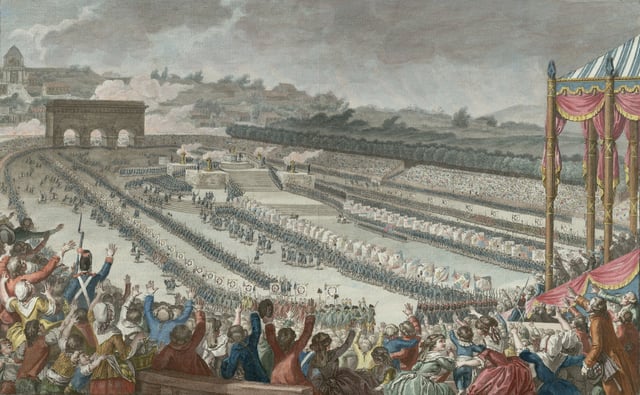
The Fête de la Fédération on 14 July 1790 celebrated the establishment of the constitutional monarchy.
Factions within the Assembly began to clarify. The aristocrat Jacques Antoine Marie de Cazalès and the abbé Jean-Sifrein Maury led what would become known as the right wing, the opposition to revolution (this party sat on the right-hand side of the Assembly). The "Royalist democrats" or monarchiens, allied with Necker, inclined towards organising France along lines similar to the British constitutional model; they included Jean Joseph Mounier, the Comte de Lally-Tollendal, the comte de Clermont-Tonnerre, and Pierre Victor Malouet, comte de Virieu.
The "National Party", representing the centre or centre-left of the assembly, included Honoré Mirabeau, Lafayette, and Bailly; while Adrien Duport, Barnave and Alexandre Lameth represented somewhat more extreme views. Almost alone in his radicalism on the left was the Arras lawyer Maximilien Robespierre. Abbé Sieyès led in proposing legislation in this period and successfully forged consensus for some time between the political centre and the left. In Paris, various committees, the mayor, the assembly of representatives, and the individual districts each claimed authority independent of the others. The increasingly middle-class National Guard under Lafayette also slowly emerged as a power in its own right, as did other self-generated assemblies.
The Assembly abolished the symbolic paraphernalia of the Ancien Régime – armorial bearings, liveries, etc. – which further alienated the more conservative nobles, and added to the ranks of the émigrés. On 14 July 1790, and for several days following, crowds in the Champ de Mars celebrated the anniversary of the fall of the Bastille with the Fête de la Fédération; Talleyrand performed a mass; participants swore an oath of "fidelity to the nation, the law, and the king"; the King and the royal family actively participated.[86]
The electors had originally chosen the members of the Estates-General to serve for a single year. However, by the terms of the Tennis Court Oath, the communes had bound themselves to meet continuously until France had a constitution. Right-wing elements now argued for a new election, but Mirabeau prevailed, asserting that the status of the assembly had fundamentally changed, and that no new election should take place before completing the constitution.[87]
In late 1790 the French army was in considerable disarray. The military officer corps was largely composed of noblemen, who found it increasingly difficult to maintain order within the ranks. In some cases, soldiers (drawn from the lower classes) had turned against their aristocratic commanders and attacked them. At Nancy, General Bouillé successfully put down one such rebellion, only to be accused of being anti-revolutionary for doing so. This and other such incidents spurred a mass desertion as more and more officers defected to other countries, leaving a dearth of experienced leadership within the army.[88]
This period also saw the rise of the political "clubs" in French politics. Foremost among these was the Jacobin Club; 152 members had affiliated with the Jacobins by 10 August 1790. The Jacobin Society began as a broad, general organisation for political debate, but as it grew in members, various factions developed with widely differing views. Several of these factions broke off to form their own clubs, such as the Club of '89.[89]
Meanwhile, the Assembly continued to work on developing a constitution. A new judicial organisation made all magistracies temporary and independent of the throne. The legislators abolished hereditary offices, except for the monarchy itself. Jury trials started for criminal cases. The King would have the unique power to propose war, with the legislature then deciding whether to declare war. The Assembly abolished all internal trade barriers and suppressed guilds, masterships, and workers' organisations: any individual gained the right to practise a trade through the purchase of a license; strikes became illegal.[90]
Royal flight to Varennes
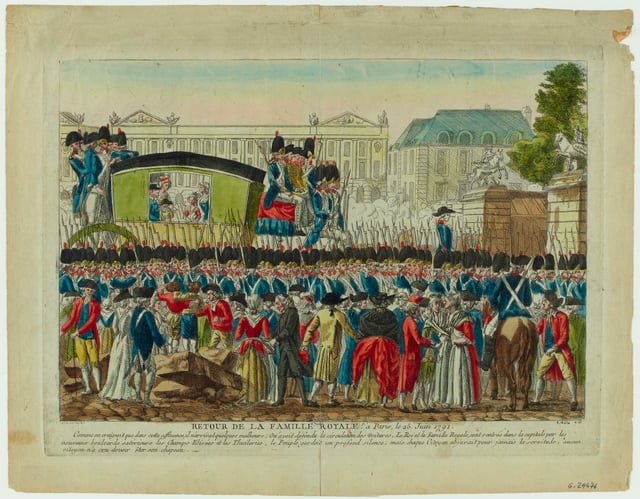
The return of the royal family to Paris on 25 June 1791, after their failed flight to Varennes
Louis XVI was increasingly dismayed by the direction of the revolution. His brother, the Comte d'Artois and his queen, Marie Antoinette, urged a stronger stance against the revolution and support for the émigrés, while he was resistant to any course that would see him openly side with foreign powers against the Assembly. Eventually, fearing for his own safety and that of his family, he decided to flee Paris to the Austrian border, having been assured of the loyalty of the border garrisons.
Louis cast his lot with General Bouillé, who condemned both the emigration and the Assembly, and promised him refuge and support in his camp at Montmédy. On the night of 20 June 1791 the royal family fled the Tuileries Palace dressed as servants, while their servants dressed as nobles.
However, late the next day, the King was recognised and arrested at Varennes and returned to Paris. The Assembly provisionally suspended the King. He and Queen Marie Antoinette remained held under guard.[91] The King's flight had a profound impact on public opinion, turning popular sentiment further against the clergy and nobility, and built momentum for the institution of a constitutional monarchy.[91]
Completing the constitution
As most of the Assembly still favoured a constitutional monarchy rather than a republic, the various groups reached a compromise which left Louis XVI as little more than a figurehead: he was forced to swear an oath to the constitution, and a decree declared that retracting the oath, heading an army for the purpose of making war upon the nation, or permitting anyone to do so in his name would amount to abdication.
However, Jacques Pierre Brissot drafted a petition, insisting that in the eyes of the nation Louis XVI was deposed since his flight. An immense crowd gathered in the Champ de Mars to sign the petition. Georges Danton and Camille Desmoulins gave fiery speeches. The Assembly called for the municipal authorities to "preserve public order". The National Guard under Lafayette's command confronted the crowd. The soldiers responded to a barrage of stones by firing into the crowd, killing between 13 and 50 people.[92] The incident cost Lafayette and his National Guard much public support.
In the wake of the massacre the authorities closed many of the patriotic clubs, as well as radical newspapers such as Jean-Paul Marat's L'Ami du Peuple. Danton fled to England; Desmoulins and Marat went into hiding.[93]
Meanwhile, in August 1791, a new threat arose from abroad: the King's brother-in-law Holy Roman Emperor Leopold II, King Frederick William II of Prussia, and the King's brother Charles-Philippe, comte d'Artois, issued the Declaration of Pillnitz, declaring their intention to bring the French king in the position "to consolidate the basis of a monarchical government" and that they were preparing their own troops for action,[94] hinting at an invasion of France on the King's behalf.[95]
Although Leopold himself sought to avoid war and made the declaration to satisfy the Comte d'Artois and the other émigrés, the reaction within France was ferocious. The French people expressed no respect for the dictates of foreign monarchs, and the threat of force merely hastened their militarisation.[96]
Even before the Flight to Varennes, the Assembly members had determined to debar themselves from the legislature that would succeed them, the Legislative Assembly. They now gathered the various constitutional laws they had passed into a single constitution, and submitted it to the recently restored Louis XVI, who accepted it, writing "I engage to maintain it at home, to defend it from all attacks from abroad, and to cause its execution by all the means it places at my disposal". The King addressed the Assembly and received enthusiastic applause from members and spectators. With this capstone, the National Constituent Assembly adjourned in a final session on 30 September 1791.[97]
Legislative Assembly (Oct. 1791 – Sept. 1792)
The Legislative Assembly first met on 1 October 1791, elected by those 4 million men – out of a population of 6 million men over the age of 25 – who paid a certain minimum amount of taxes.[98] Under the Constitution of 1791, France would function as a constitutional monarchy. The King had to share power with the elected Legislative Assembly, but he retained his royal veto and the ability to select ministers. Early on, the King vetoed legislation that threatened the émigrés with death and that decreed that every non-juring clergyman must take within eight days the civic oath mandated by the Civil Constitution of the Clergy. Over the course of a year, such disagreements would lead to a constitutional crisis.
Late in 1791, a group of Assembly members who propagated war against Austria and Prussia was, after some remark of politician Maximilien Robespierre, henceforth indicated as the 'Girondins', although not all of them really came from the southern province of Gironde. A group around Robespierre – later indicated as 'Montagnards' or 'Jacobins' – pleaded against that war; this opposition between those groups would harden and embitter in the next 11/2 years.[94]
In response to the threat of war of August 1791 from Austria and Prussia, leaders of the Assembly saw such a war as a means to strengthen support for their revolutionary government, and the French people as well as the Assembly thought that they would win a war against Austria and Prussia. On 20 April 1792, France declared war on Austria.[94][99] Late April 1792, France invaded and conquered the Austrian Netherlands (roughly present-day Belgium and Luxembourg).[94]
Failure of the constitutional monarchy
The Legislative Assembly degenerated into chaos before October 1792. Francis Charles Montague concluded in 1911, "In the attempt to govern, the Assembly failed altogether. It left behind an empty treasury, an undisciplined army and navy, and a people debauched by safe and successful riot."[100]
Lyons argues that the Constituent Assembly had liberal, rational, and individualistic goals that seem to have been largely achieved by 1791. However, it failed to consolidate the gains of the Revolution, which continued with increasing momentum and escalating radicalism until 1794. Lyons identifies six reasons for this escalation. First, the king did not accept the limitations on his powers, and mobilised support from foreign monarchs to reverse it. Second, the effort to overthrow the Roman Catholic Church, sell off its lands, close its monasteries and its charitable operations, and replace it with an unpopular makeshift system caused deep consternation among the pious and the peasants. Third, the economy was badly hurt by the issuance of ever increasing amounts of paper money (assignats), which caused more and more inflation; the rising prices hurt the urban poor who spent most of their income on food. Fourth, the rural peasants demanded liberation from the heavy system of taxes and dues owed to local landowners. Fifth, the working class of Paris and the other cities – the sans-culottes – resented the fact that the property owners and professionals had taken all the spoils of the Revolution. Finally, foreign powers threatened to overthrow the Revolution, which responded with extremism and systematic violence in its own defence.[101]
Constitutional crisis
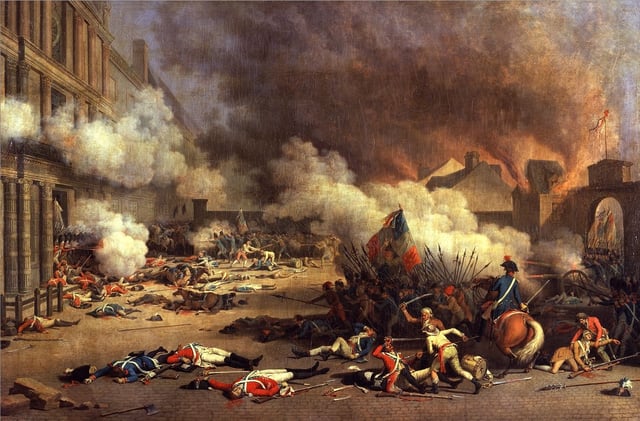
On 10 August 1792 the Paris Commune stormed the Tuileries Palace and killed the Swiss Guards.
In the summer of 1792, all of Paris was against the king, and hoped that the Assembly would depose the king, but the Assembly hesitated.[102] At dawn of 10 August 1792, a large, angry crowd of Parisians and soldiers from all over France,[102] insurgents and popular militias, supported by the revolutionary Paris Commune,[103] marched on the Tuileries Palace where the king resided,[102] assailed the Palace and killed the Swiss Guards who were assigned for the protection of the king.[103]
Around 8:00 am the king decided to leave his palace and seek safety with his wife and children in the Assembly that was gathered in permanent session in Salle du Manège opposite to the Tuileries.[102] The royal family became prisoners.[104] After 11:00 am, a rump session of the Legislative Assembly 'temporarily relieved the king from his task'[102] and thus suspended the monarchy; little more than a third of the deputies were present, almost all of them Jacobins.[104] In reaction, on 19 August the Prussian general Duke of Brunswick invaded France[105] and besieged Longwy.[106]
On 26 August, the Assembly decreed the deportation of refractory priests in the west of France, as "causes of danger to the fatherland", to destinations like French Guiana. In reaction, peasants in the Vendée took over a town, in another step toward civil war.[106] What remained of a national government depended on the support of the insurrectionary Commune. With enemy troops advancing, the Commune looked for potential traitors in Paris.[107][108]
On 2, 3 and 4 September 1792, hundreds of Parisians, supporters of the revolution, infuriated by Verdun being captured by the Prussian enemy, the uprisings in the west of France, and rumours that the incarcerated prisoners in Paris were conspiring with the foreign enemy, raided the Parisian prisons and murdered between 1,000 and 1,500 prisoners, many of them Catholic priests but also common criminals. Jean-Paul Marat, a political ally of Robespierre, in an open letter on 3 September incited the rest of France to follow the Parisian example; Robespierre kept a low profile in regard to the murder orgy.[109] The Assembly and the city council of Paris (la Commune) seemed inept and hardly motivated to call a halt to the unleashed bloodshed.[102]
The Commune sent gangs of National Guardsmen and fédérés into the prisons, and they killed 10 or more victims, mostly nonjuring priests. The Commune then sent a circular letter to the other cities of France inviting them to follow this example, and many cities launched their own massacres of prisoners and priests in the "September massacres". The Assembly could offer only feeble resistance. In October, however, there was a counterattack accusing the instigators, especially Marat, of being terrorists. This led to a political contest between the more moderate Girondists and the more radical Montagnards inside the Convention, with rumour used as a weapon by both sides. The Girondists lost ground when they seemed too conciliatory. But the pendulum swung again and after Thermidor, the men who had endorsed the massacres were denounced as terrorists.[107][108]
Chaos persisted until the Convention, elected by universal male suffrage and charged with writing a new constitution, met on 20 September 1792 and became the new de facto government of France. The next day it abolished the monarchy and declared a republic. The following day – 22 September 1792, the first morning of the new Republic – was later retroactively adopted as the beginning of Year One of the French Republican Calendar.[110]
French Revolutionary Wars and Napoleonic Wars

French victory over the Prussians at the Battle of Valmy on 20 September 1792
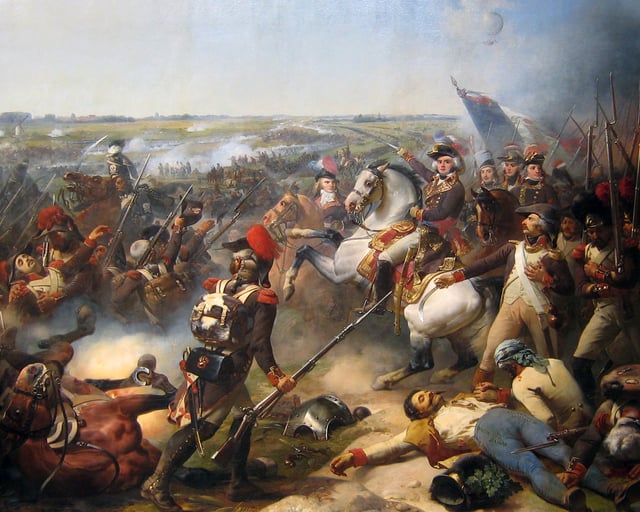
The French Revolutionary Army defeated the combined armies of Austrians, Dutch and British at Fleurus in June 1794.
From 1793 to 1815 France was engaged almost continuously (with two short breaks) in wars with Britain and a changing coalition of other major powers. The many French successes led to the spread of the French revolutionary ideals into neighbouring countries, and indeed across much of Europe. However, the final defeat of Napoleon in 1814 (and 1815) brought a reaction that reversed some – but not all – of the revolutionary achievements in France and Europe. The Bourbons were restored to the throne, with the brother of King Louis XVI becoming King Louis XVIII.
The politics of the period inevitably drove France towards war with Austria and its allies. The King, many of the Feuillants, and the Girondins specifically wanted to wage war. The King (and many Feuillants with him) expected war would increase his personal popularity; he also foresaw an opportunity to exploit any defeat: either result would make him stronger. The Girondins wanted to export the Revolution throughout Europe and, by extension, to defend the Revolution within France. The forces opposing war were much weaker. Barnave and his supporters among the Feuillants feared a war they thought France had little chance to win and which they feared might lead to greater radicalisation of the revolution. On the other end of the political spectrum Robespierre opposed a war on two grounds, fearing that it would strengthen the monarchy and military at the expense of the revolution, and that it would incur the anger of ordinary people in Austria and elsewhere. The Austrian emperor Leopold II, brother of Marie Antoinette, may have wished to avoid war, but he died on 1 March 1792.[111] France preemptively declared war on Austria (20 April 1792) and Prussia joined on the Austrian side a few weeks later. The invading Prussian army faced little resistance until it was checked at the Battle of Valmy (20 September 1792) and forced to withdraw.
The new-born Republic followed up on this success with a series of victories in Belgium and the Rhineland in the fall of 1792. The French armies defeated the Austrians at the Battle of Jemappes on 6 November, and had soon taken over most of the Austrian Netherlands. This brought them into conflict with Britain and the Dutch Republic, which wished to preserve the independence of the southern Netherlands from France. After the French king's execution in January 1793, these powers, along with Spain and most other European states, joined the war against France. Almost immediately, French forces suffered defeats on many fronts, and were driven out of their newly conquered territories in the spring of 1793. At the same time, the republican regime was forced to deal with rebellions against its authority in much of western and southern France. But the allies failed to take advantage of French disunity, and by the autumn of 1793 the republican regime had defeated most of the internal rebellions and halted the allied advance into France itself.
This stalemate ended in the summer of 1794 with dramatic French victories. The French defeated the allied army at the Battle of Fleurus, leading to a full Allied withdrawal from the Austrian Netherlands. They pushed the allies to the east bank of the Rhine, allowing France, by the beginning of 1795, to conquer the Dutch Republic itself. The House of Orange was expelled and replaced by the Batavian Republic, a French satellite state. These victories led to the collapse of the anti-French coalition. Prussia, having effectively abandoned the coalition in the fall of 1794, made peace with revolutionary France at Basel in April 1795, and soon thereafter Spain also made peace with France. Britain and Austria were the only major powers to remain at war with France.
Colonial uprisings

Slave revolt in Saint Domingue
Although the French Revolution had a dramatic impact in numerous areas of Europe, the French colonies felt a particular influence. As the Martinican author Aimé Césaire put it, "there was in each French colony a specific revolution, that occurred on the occasion of the French Revolution, in tune with it."[112] The Haitian Revolution (Saint Domingue) became a central example of slave uprisings in French colonies.
First Republic
National Convention (Sept. 1792–95)
Late in August 1792, elections were held, now under male universal suffrage, for the new National Convention,[109] which replaced the Legislative Assembly on 20 September 1792. From the start the Convention suffered from the bitter division between a group around Robespierre, Danton and Marat, referred to as 'Montagnards' or 'Jacobins' or the 'left', and a group referred to as 'Girondins' or the 'right'. But the majority of the representatives, referred to as 'la Plaine', were member of neither of those two antagonistic groups and managed to preserve some speed in the Convention's debates.[109][113]
Immediately on 21 September the Convention abolished the monarchy, making France the French First Republic.[102] A new French Republican Calendar was introduced to replace the Christian Gregorian calendar, renaming the year 1792 as year 1 of the Republic.[58]
With wars against Prussia and Austria having started earlier in 1792, France also declared war on the Kingdom of Great Britain and the Dutch Republic in November 1792.[113] In the course of 1793, the Holy Roman Empire, the kings of Portugal and Naples and the Grand-Duke of Tuscany declared war against France.[114]
Execution of Louis XVI
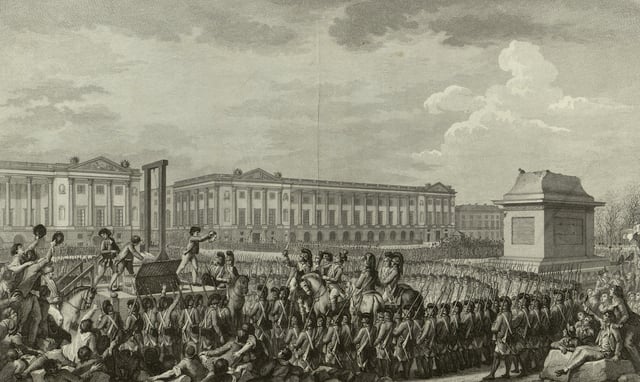
Execution of Louis XVI in what is now the Place de la Concorde, facing the empty pedestal where the statue of his grandfather, Louis XV, had stood
In the Brunswick Manifesto, the Imperial and Prussian armies threatened retaliation on the French population if it were to resist their advance or the reinstatement of the monarchy. This among other things made Louis appear to be conspiring with the enemies of France. On 17 January 1793 Louis was condemned to death for "conspiracy against the public liberty and the general safety" by a close majority in Convention: 361 voted to execute the king, 288 voted against, and another 72 voted to execute him subject to a variety of delaying conditions. The former Louis XVI, now simply named Citoyen Louis Capet (Citizen Louis Capet) was executed by guillotine on 21 January 1793 on the Place de la Révolution, former Place Louis XV, now called the Place de la Concorde.[115] Conservatives across Europe were horrified and monarchies called for war against revolutionary France.[116][117]
Economy
When war went badly, prices rose and the sans-culottes – poor labourers and radical Jacobins – rioted; counter-revolutionary activities began in some regions. This encouraged the Jacobins to seize power through a parliamentary coup, backed up by force effected by mobilising public support against the Girondist faction, and by utilising the mob power of the Parisian sans-culottes. An alliance of Jacobin and sans-culottes elements thus became the effective centre of the new government. Policy became considerably more radical, as "The Law of the Maximum" set food prices and led to executions of offenders.[118]
The price control policy was coeval with the rise to power of the Committee of Public Safety and the Reign of Terror. The Committee first attempted to set the price for only a limited number of grain products, but by September 1793 it expanded the "maximum" to cover all foodstuffs and a long list of other goods.[119] Widespread shortages and famine ensued. The Committee reacted by sending dragoons into the countryside to arrest farmers and seize crops. This temporarily solved the problem in Paris, but the rest of the country suffered. By the spring of 1794, forced collection of food was not sufficient to feed even Paris, and the days of the Committee were numbered. When Robespierre went to the guillotine in July 1794, the crowd jeered, "There goes the dirty maximum!"[120]
Reign of Terror

Queen Marie Antoinette on the way to the guillotine on 16 October 1793 (drawing by Jacques-Louis David)
'Reign of Terror' is a label used by some historians for (part of) French history between July 1789 and July 1794, but those historians adhere that label to different periods.
The Committee of Public Safety came under the control of Maximilien Robespierre, a lawyer, and the Jacobins unleashed the Reign of Terror (1793–94). According to archival records, at least 16,594 people died under the guillotine or otherwise after accusations of counter-revolutionary activities.[121] As many as 40,000 accused prisoners may have been summarily executed without trial or died awaiting trial.[121][122]
On 2 June 1793, Paris sections – encouraged by the enragés ("enraged ones") Jacques Roux and Jacques Hébert – took over the Convention, calling for administrative and political purges, a low fixed price for bread, and a limitation of the electoral franchise to sans-culottes alone.[123] With the backing of the National Guard, they managed to persuade the Convention to arrest 31 Girondin leaders, including Jacques Pierre Brissot. Following these arrests, the Jacobins gained control of the Committee of Public Safety on 10 June, installing the revolutionary dictatorship.[124]
On 24 June, the Convention adopted the first republican constitution of France, variously referred to as the French Constitution of 1793 or Constitution of the Year I. It was progressive and radical in several respects, in particular by establishing universal male suffrage. It was ratified by public referendum, but normal legal processes were suspended before it could take effect.[125]
On 13 July, the assassination of Jean-Paul Marat – a Jacobin leader and journalist known for his bloodthirsty rhetoric – by Charlotte Corday, a Girondin, resulted in further increase of Jacobin political influence. Georges Danton, the leader of the August 1792 uprising against the king, undermined by several political reversals, was removed from the Committee and Robespierre, "the Incorruptible", became its most influential member as it moved to take radical measures against the Revolution's domestic and foreign enemies.[124]
The Reign of Terror ultimately weakened the revolutionary government, while temporarily ending internal opposition. The Jacobins expanded the size of the army, and Carnot replaced many aristocratic officers with soldiers who had demonstrated their patriotism, if not their ability. The Republican army repulsed the Austrians, Prussians, British, and Spanish. At the end of 1793, the army began to prevail and revolts were defeated with ease. The Ventôse Decrees (February–March 1794) proposed the confiscation of the goods of exiles and opponents of the Revolution, and their redistribution to the needy. However, this policy was never fully implemented.[126]
Three approaches attempt to explain the Reign of Terror imposed by the Jacobins in 1793–94. The older Marxist interpretation argued the Terror was a necessary response to outside threats (in terms of other countries going to war with France) and internal threats (of traitors inside France threatening to frustrate the Revolution). In this interpretation, as expressed by the Marxist historian Albert Soboul, Robespierre and the sans-culottes were heroes for defending the revolution from its enemies. François Furet has argued that foreign threats had little to do with the terror.[127] Instead, the extreme violence was an inherent part of the intense ideological commitment of the revolutionaries – their utopian goals required exterminating opposition. Soboul's Marxist interpretation has been largely abandoned by most historians since the 1990s. Hanson (2009) takes a middle position, recognising the importance of the foreign enemies, and sees the terror as a contingency that was caused by the interaction of a series of complex events and the foreign threat. Hanson says the terror was not inherent in the ideology of the Revolution, but that circumstances made it necessary.[128]
Internal and external wars
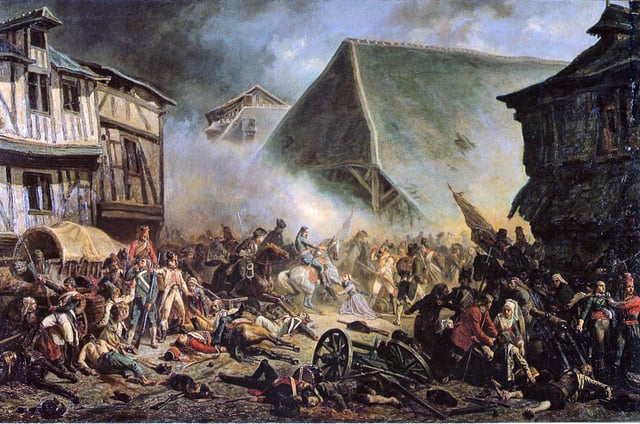
The War in the Vendée was a royalist uprising that was suppressed by the republican forces in 1796.
Introduction of a nationwide conscription for the army in February 1793 was the spark that in March made the Vendée, already rebellious since 1790 because of the changes imposed on the Roman Catholic Church by the Civil Constitution of the Clergy (1790),[129] ignite into civil (guerrilla) war against the French Revolutionary government in Paris.[113][130][131][132]
North of the Loire, similar revolts were started by the so-called Chouans (royalist rebels).[133] In March 1793, France also declared war on Spain, the Vendée rebels won some victories against Paris, and the French army was defeated in Belgium by Austria with the French general Dumouriez defecting to the Austrians: the French Republic's survival was now in real danger.[113] Facing local revolts and foreign invasions in both the East and West of the country, the most urgent government business was the war.[134] On 6 April 1793, to prevent the Convention from losing itself in abstract debate and to streamline government decisions, the Comité de salut public (Committee of Public Prosperity) was created, as executive government which was accountable to the Convention.[113]
Girondins expelled
In April 1793, the Girondins indicted Jean-Paul Marat before the Revolutionary Tribunal for 'attempting to destroy the sovereignty of the people' and 'preaching plunder and massacre', referring to his behaviour during the September 1792 Paris massacres. Marat was quickly acquitted but the incident further exacerbated the 'Girondins' versus 'Montagnards' party strife in the Convention.[113]
Jacques Hébert, Convention member leaning to the 'Montagnards' group, on 24 May 1793 called on the sans-culottes to rise in revolt against the "henchmen of Capet [the ex-king] and Dumouriez [the defected general]". Hébert was arrested by a Convention committee. While that committee consisted only of members from la Plaine and the Girondins, the anger of the sans-culottes was directed towards the Girondins. 25 May, a delegation of la Commune (the Paris city council) protested against Hébert's arrest. The Convention's President Isnard, a Girondin, answered them: "Members of la Commune [...] If by your incessant rebellions something befalls to the representatives of the nation, I declare, in the name of France, that Paris will be totally obliterated".[113]
On 2 June 1793, the Convention's session in Tuileries Palace degenerated into chaos and pandemonium. Crowds of people swarmed in and around the palace. Incessant screaming from the public galleries suggested that all of Paris was against the Girondins. Petitions circulated, indicting and condemning 22 Girondins. Barère, member of the Comité de salut public, suggested: to end this division which is harming the Republic, the Girondin leaders should lay down their offices voluntarily. Late that night after much more tumultuous debate, dozens of Girondins had resigned and left the Convention.[113]
Abounding civil war
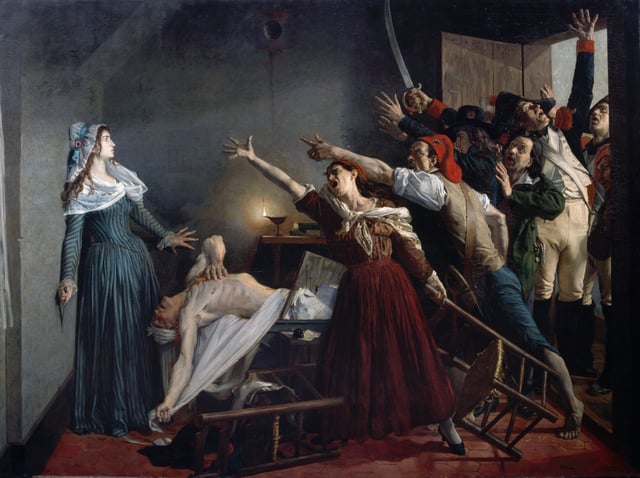
The assassination of Jean-Paul Marat by Girondist sympathizer Charlotte Corday on 13 July 1793
By the summer of 1793, most French departments in one way or another opposed the central Paris government. Girondins who fled from Paris after 2 June led those revolts.[135] In Brittany's countryside, the people rejecting the Civil Constitution of the Clergy of 1790 had taken to a guerrilla warfare known as Chouannerie.[129] But generally, the French opposition against 'Paris' had now evolved into a plain struggle for power over the country[135] against the 'Montagnards' around Robespierre and Marat now dominating Paris.[129]
In June–July 1793, Bordeaux, Marseilles, Brittany, Caen and the rest of Normandy gathered armies to march on Paris and against 'the revolution'.[130][129] In July, Lyon guillotined the deposed 'Montagnard' head of the city council.[129] Barère, member of the Committee of Public Prosperity, on 1 August incited the Convention to tougher measures against the Vendée, at war with Paris since March: "We'll have peace only when no Vendée remains [...] we'll have to exterminate that rebellious people".[130] In August, Convention troops besieged Lyon.[129]
On 17 August 1793, the Convention voted for general conscription, the levée en masse, which mobilised all citizens to serve as soldiers or suppliers in the war effort.[134] The consecutive successes in the French revolutionary wars earned Lazare Carnot the title 'Organizer of Victory'.[136][137]
In August–September 1793, militants urged the Convention to do more to quell the counter-revolution. A delegation of the Commune (Paris city council) suggested to form revolutionary armies to arrest hoarders and conspirators.[129] Barère, member of the Committee of Public Prosperity – the de facto executive government – ever since April 1793,[135] among others on 5 September reacted favorably, saying: let's "make terror the order of the day!"[129] The National Convention on 9 September voted to establish sans-culottes paramilitary forces, revolutionary armies, and to force farmers to surrender grain demanded by the government.[134] On 17 September, the Law of Suspects was passed, which ordered the arrest of suspected counter-revolutionaries and people who had revealed themselves as "enemies of freedom".[138] This decree was one of the causes for some 17,000 legal death sentences until the end of July 1794, an average of 370 per week – reason for historians to label those 101/2 months 'the (Reign of) Terror'.[139][140]
Criteria for bringing someone before the Revolutionary Tribunal, created March 1793, had always been vast and vague.[135] By August, political disagreement seemed enough to be summoned before the Tribunal; appeal against a Tribunal verdict was impossible.[129] Late August 1793, an army general had been guillotined on the accusation of choosing too timid strategies on the battlefield.[129] Mid-October, the widowed former queen Marie Antoinette was on trial for a long list of charges such as "teaching [her husband] Louis Capet the art of dissimulation" and incest with her son, she too was guillotined.[129] In October 1793, 21 former 'Girondins' Convention members who hadn't left Paris after June were convicted to death and executed, on the charge of verbally supporting the preparation of an insurrection in Caen by fellow-Girondins.[129]
Suppressing and retaliating the revolts
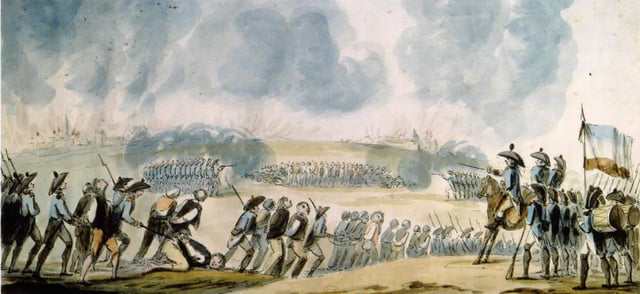
Mass shootings at Nantes in 1793
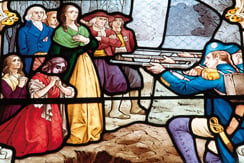
Shootings and massacres by the Infernal columns under Louis Marie Turreau
17 October 1793, the 'blue' Republican army near Cholet defeated the 'white' Vendéan insubordinate army and all surviving Vendée residents, counting in tens of thousands, fled over the river Loire north into Brittany.[130] A Convention's representative on mission in Nantes commissioned in October to pacify the region did so by simply drowning prisoners in the river Loire: until February 1794 he drowned at least 4,000.[135]
Meanwhile, the instalment of the Republican Calendar on 24 October 1793 caused an anti-clerical uprising. Hébert's and Chaumette's atheist movement campaigned to dechristianise society. The climax was reached with the celebration of the flame of Reason in Notre Dame Cathedral on 10 November.[141]
By November 1793, the revolts in Normandy, Bordeaux and Lyon were overcome, in December also that in Toulon.[129] Two representatives on mission sent to punish Lyon between November 1793 and April 1794 executed 2,000 people to death by guillotine or firing-squad.[135] The Vendéan army since October roaming through Brittany on 12 December 1793 again ran up against Republican troops and saw 10,000 of its rebels perish, meaning the end of this once threatening army.[135]
Some historians claim that after that Vendéan defeat Convention Republic armies in 1794 massacred 117,000 Vendéan civilians to obliterate the Vendéan people, but others contest that claim.[142] Some historians consider the total civil war to have lasted until 1796 with a toll of 170,000[143] or 450,000 lives.[144][145]
Because of the extremely brutal forms that the Republican repression took in many places, historians such as Reynald Secher have called the event a "genocide".[146][147][148] Historian François Furet concluded that the repression in the Vendee "not only revealed massacre and destruction on an unprecedented scale but also a zeal so violent that it has bestowed as its legacy much of the region's identity."[149]
Profuse executions
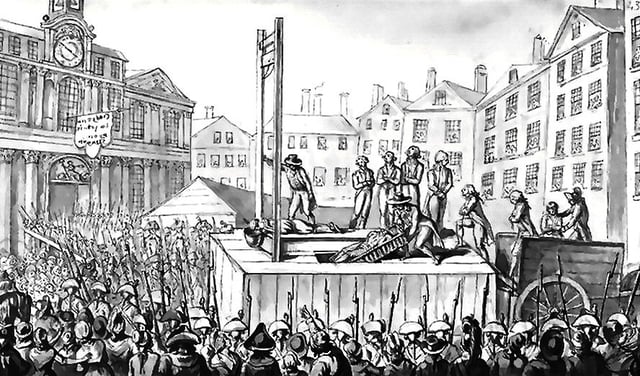
Nine emigrants go to the guillotine in 1793
The guillotine became the tool for a string of executions. Louis XVI had already been guillotined before the start of the terror; Queen Marie Antoinette, Barnave, Bailly, Brissot and other leading Girondins, Philippe Égalité (despite his vote for the death of the King), Madame Roland and many others were executed by guillotine. The Revolutionary Tribunal summarily condemned thousands of people to death by the guillotine, while mobs beat other victims to death.
At the peak of the terror, the slightest hint of counter-revolutionary thoughts or activities (or, as in the case of Jacques Hébert, revolutionary zeal exceeding that of those in power) could place one under suspicion, and trials did not always proceed according to contemporary standards of due process. Sometimes people died for their political opinions or actions, but many for little reason beyond mere suspicion, or because some others had a stake in getting rid of them. Most of the victims received an unceremonious trip to the guillotine in an open wooden cart (the tumbrel). In the rebellious provinces, the government representatives had unlimited authority and some engaged in extreme repressions and abuses. For example, Jean-Baptiste Carrier became notorious for the Noyades ("drownings") he organised in Nantes;[150] his conduct was judged unacceptable even by the Jacobin government and he was recalled.[151]
Guillotining politicians

The Festival of the Supreme Being on 8 June 1794
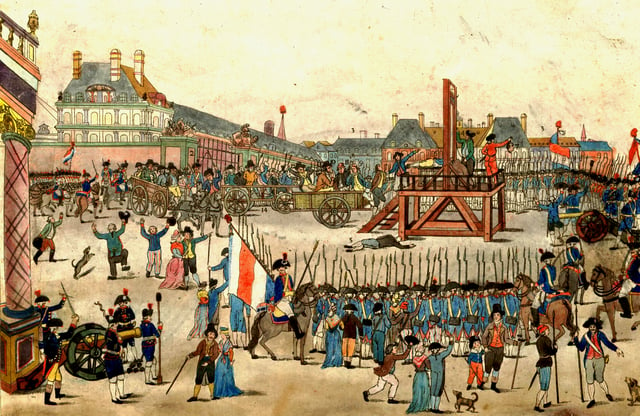
The execution of Robespierre on 28 July 1794 marked the end of the Reign of Terror.
Maximilien Robespierre, since July 1793 member of the Committee of Public Prosperity,[130] on 5 February 1794 in a speech in the Convention identified Jacques Hébert and his faction as "internal enemies" working toward the triumph of tyranny.[135] After a dubious trial Hébert and some allies, charged with counter-revolutionary activities,[152] were guillotined in March.[135]
On 5 April, again at the instigation of Robespierre, Danton, a moderate Montagnard, and 13 associated politicians, charged with counter-revolutionary activities,[152] were executed.[135] A week later again 19 politicians. This hushed the Convention deputies: if henceforth they disagreed with Robespierre they hardly dared to speak out.[135]
On 7 June 1794, Robespierre advocated a new state religion and recommended the Convention acknowledge the existence of the "Supreme Being".[152] A law enacted on 10 June 1794 (22 Prairial II) further streamlined criminal procedures: if the Revolutionary Tribunal saw sufficient proof of someone being an "enemy of the people" a counsel for defence would not be allowed. The frequency of guillotine executions in Paris now rose from on average three a day to an average of 29 a day.[135]
Meanwhile, France's external wars were going well, with victories over Austrian and British troops in May and June 1794 opening up Belgium for French conquest.[135] But cooperation within the Committee of Public Prosperity, since April 1793 the de facto executive government, started to break down. On 29 June 1794, three colleagues of Robespierre at 'the Committee' called him a dictator in his face – Robespierre baffled left the meeting. This encouraged other Convention members to also defy Robespierre. On 26 July, a long and vague speech of Robespierre wasn't met with thunderous applause as usual but with hostility; some deputies yelled that Robespierre should have the courage to say which deputies he deemed necessary to be killed next, what Robespierre refused to do.[135]
In the Convention session of 27 July 1794 (9 Thermidor of Year II), Robespierre and his allies hardly managed to say a word as they were constantly interrupted by a row of critics such as Tallien, Billaud-Varenne, Vadier, Barère and acting president Thuriot. Finally, even Robespierre's own voice failed on him: it faltered at his last attempt to beg permission to speak.[135]
A decree was adopted to arrest Robespierre, Saint-Just and Couthon. 28 July, they and 19 other leading Jacobins were beheaded. 29 July, again 70 Parisians were guillotined.[135]
Subsequently, the Law of 22 Prairial (10 June 1794) was repealed, and the 'Girondins' expelled from the Convention in June 1793, if not dead yet, were reinstated as Convention deputies.[153]
Disregarding the lower classes
After July 1794, the French government was dominated by 'Girondins', who indulged in revenge and violence and death sentences against people associated with the previous 'Jacobin'/'Montagnard' governments around Robespierre and Marat, in what was known as the White Terror.[154] The Jacobin Club was closed and banned.[155][156]
After July 1794, most civilians henceforth ignored the Republican calendar and returned to the traditional seven-day weeks. The government in a law of 21 February 1795 set steps of return to freedom of religion and reconciliation with the since 1790 refractory Catholic priests, but any religious signs outside churches or private homes, such as crosses, clerical garb, bell ringing, remained prohibited. When the people's enthusiasm for attending church grew to unexpected levels the government backed out and in October 1795 again, like in 1790, required all priests to swear oaths on the Republic.[153]
In the very cold winter of 1794–95, the French army was demanding more and more bread. It was getting scarce in Paris, as was wood to keep houses warm. As a result, in an echo of the October 1789 March on Versailles, on 1 April 1795 (12 Germinal III) a mostly female crowd marched on the Convention calling for bread. But no Convention member sympathized, and they told the women to return home. Again in May, a crowd of 20,000 men and 40,000 women invaded the Convention and killed a deputy in the halls, but again they failed to make the Convention take notice of the needs of the lower classes. Instead, the Convention banned women from all political assemblies, and deputies who had stood with this insurrection were sentenced to death: such allegiance between parliament and street fighting was no longer tolerated.[153]
Late 1794, France conquered present-day Belgium.[157] In January 1795 they subdued the Dutch Republic with full consent and cooperation of the influential Dutch patriottenbeweging ('patriots movement'), resulting in the Batavian Republic, a satellite and puppet state of France.[158][159] In April 1795, France concluded a peace agreement with Prussia,[160] later that year peace was agreed with Spain.
The Directory (1795–99)
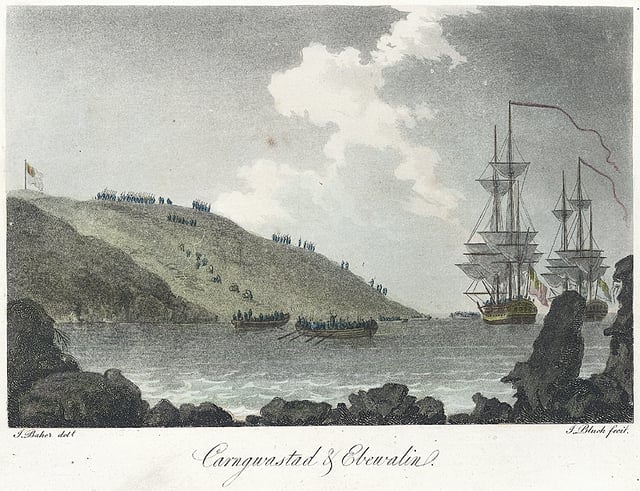
A small French force tried to invade Britain in February 1797. This contemporary image shows troops landing near Fishguard in Wales. The troops were later forced to surrender.
The Convention on 22 August 1795 approved the new "Constitution of the Year III". A French plebiscite ratified the document, with about 1,057,000 votes for the constitution and 49,000 against.[161] The results of the voting were announced on 23 September 1795, and the new constitution took effect on 27 September 1795.[161] The new constitution created the Directoire (English: Directory) with a bicameral legislature.
The first chamber was called the 'Council of 500' initiating the laws, the second the 'Council of Elders' reviewing and approving or not the passed laws. Each year, one-third of the chambers was to be renewed. The executive power was in the hands of the five members (directors) of the Directory with a five-year mandate.[153]
The early directors did not much understand the nation they were governing; they especially had an innate inability to see Catholicism as anything else than counter-revolutionary and royalist. Local administrators had a better sense of people's priorities, and one of them wrote to the minister of the interior: "Give back the crosses, the church bells, the Sundays, and everyone will cry: ’vive la République!’"[153]
The Directory denounced the arbitrary executions of the Reign of Terror, but itself engaged in large scale illegal repressions, as well as large-scale massacres of civilians in the Vendee uprising. The economy continued in bad condition, with the poor especially hurt by the high cost of food.
State finances were in total disarray; the government could only cover its expenses through the plunder and the tribute of foreign countries. If peace were made, the armies would return home and the directors would have to face the exasperation of the rank-and-file who had lost their livelihood, as well as the ambition of generals who could, in a moment, brush them aside. Barras and Rewbell were notoriously corrupt themselves and screened corruption in others. The patronage of the directors was ill-bestowed, and the general maladministration heightened their unpopularity.[162]
The constitutional party in the legislature desired toleration of the nonjuring clergy, the repeal of the laws against the relatives of the émigrés, and some merciful discrimination towards the émigrés themselves. The directors baffled all such endeavours. On the other hand, the socialist conspiracy of Babeuf was easily quelled. Little was done to improve the finances, and the assignats continued to fall in value until each note was worth less than the paper it was printed on; debtors easily paid off their debts.[163] A series of financial reforms started by the Directory finally took effect after it fell from power.
Evaluation
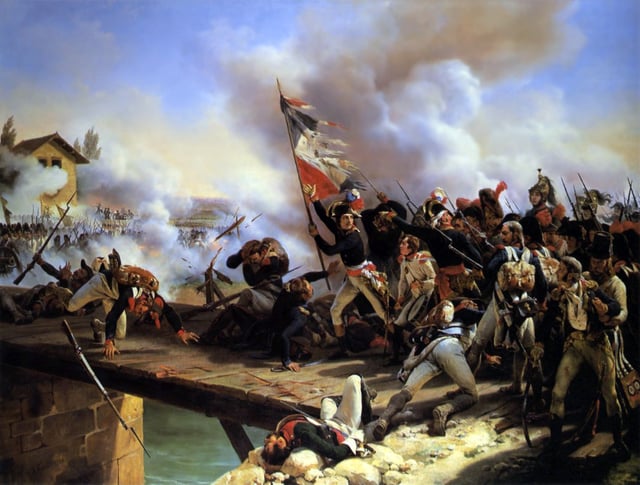
General Napoleon and his troops crossing the bridge of Arcole in 1796
Although committed to Republicanism, the Directory distrusted democracy. Historians have seldom praised the Directory; it was a government of self-interest rather than virtue, thus losing any claim on idealism. It never had a strong base of popular support; when elections were held, most of its candidates were defeated. Its achievements were minor.[164][165] Brown stresses the turn towards dictatorship and the failure of liberal democracy under the Directory, blaming it on, "chronic violence, ambivalent forms of justice, and repeated recourse to heavy-handed repression."[166]
The election system was complex and designed to insulate the government from grass roots democracy. The parliament consisted of two houses: the Conseil des Cinq-Cents (Council of the Five Hundred) with 500 representatives, and the Conseil des Anciens (Council of Elders) with 250 senators. Executive power went to five "directors," named annually by the Conseil des Anciens from a list submitted by the Conseil des Cinq-Cents. The universal male suffrage of 1793 was replaced by limited suffrage based on property. The voters had only a limited choice because the electoral rules required two-thirds of the seats go to members of the old Convention, no matter how few popular votes they received.[167]
Citizens of the war-weary nation wanted stability, peace, and an end to conditions that at times bordered on chaos. Nevertheless, those on the right who wished to restore the monarchy by putting Louis XVIII on the throne, and those on the left who would have renewed the Reign of Terror, tried but failed to overthrow the Directory. The earlier atrocities had made confidence or goodwill between parties impossible.[168] The Directory régime met opposition from Jacobins on the left and royalists on the right (the latter were secretly subsidised by the British government). The army suppressed riots and counter-revolutionary activities. In this way the army and in particular Napoleon gained total power.[169]
Coups d'état
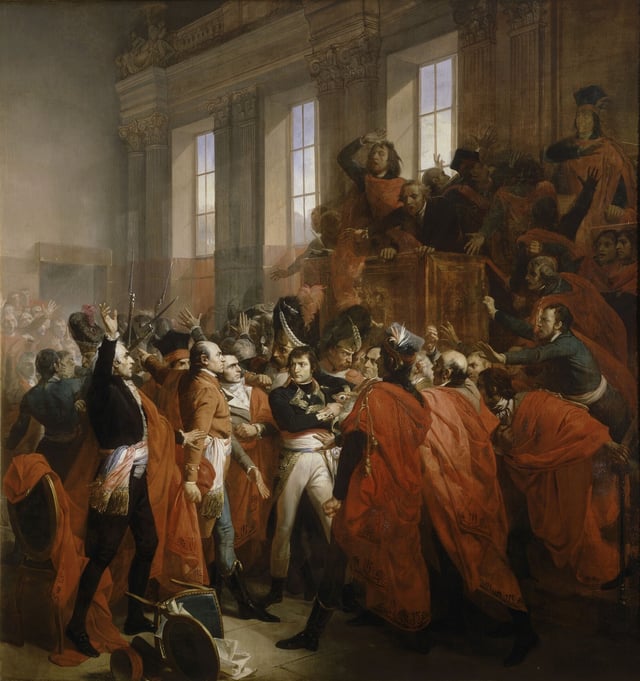
Napoléon Bonaparte in the coup d'état of 18 Brumaire VIII (9 November 1799)
Parliamentary elections in the spring of 1797, for one-third of the seats in Parliament, resulted in considerable gains for the royalists,[153] who seemed poised to take control of the Directory in the next elections. This frightened the republican directors and they reacted, in the Coup of 18 Fructidor V (4 September 1797), by purging all the winners banishing 57 leaders to certain death in Guiana, removing two supposedly pro-royalist directors, and closing 42 newspapers.
The new, 'corrected' government, still strongly convinced that Catholicism and royalism were equally dangerous to the Republic, started a fresh campaign to promote the Republican calendar (officially introduced in 1792), with its ten-day week, and tried to hallow the tenth day, décadi, as substitute for the Christian Sunday. Not only citizens opposed and even mocked such decrees, also local government officials refused to enforce such laws.[153]
France was still waging wars, in 1798 in Egypt, Switzerland, Rome, Ireland, Belgium and against the US, in 1799 in Baden-Württemberg. When the elections of 1798 were again carried by the opposition, the Directory used the army to imprison and exile the opposition leaders and close their newspapers. Increasingly it depended on the Army in foreign and domestic affairs, as well as finance.
In 1799, when the French armies abroad experienced some setbacks, the newly chosen director Sieyes considered a new overhaul necessary for the Directory's form of government because in his opinion it needed a stronger executive. Together with successful general Napoleon Bonaparte who had just returned to France, Sieyes began preparing another coup d'état, which took place on 9–10 November 1799 (18–19 Brumaire VIII), replacing the five directors now with three "consuls": Napoleon, Sieyes, and Roger Ducos.[153] That coup some historians consider the closing of the specifically republican phase of the French Revolution.[170]
Exporting the Revolution

French-Dutch victory under General Brune and General Daendels against the Russians and British in 1799
The Army at first was quite successful. It conquered Belgium and turned it into a province of France; conquered the Netherlands and made it a puppet state; and conquered Switzerland and most of Italy, setting up a series of puppet states. The result was glory for France and an infusion of much needed money from the conquered lands, which also provided direct support to the French Army. However, the enemies of France, led by Britain and funded by the inexhaustible British Treasury, formed a Second Coalition in 1799 (with Britain joined by Russia, the Ottoman Empire, and Austria). The allies scored a series of victories that rolled back French successes, retaking Italy, Switzerland and the Netherlands and ending the flow of payments from the conquered areas to France. The treasury was empty. Despite his publicity claiming many glorious victories, Napoleon's army was trapped in Egypt after the British sank the French fleet at the Battle of the Nile. Napoleon escaped by himself, returned to Paris and overthrew the Directory in November 1799.[171][172]
Napoleon conquered most of Italy in the name of the French Revolution in 1797–99. He consolidated old units and split up Austria's holdings. He set up a series of new republics, complete with new codes of law and abolition of old feudal privileges. Napoleon's Cisalpine Republic was centred on Milan. Genoa the city became a republic while its hinterland became the Ligurian Republic. The Roman Republic was formed out of the papal holdings and the pope was sent to France. The Neapolitan Republic was formed around Naples, but it lasted only five months before the enemy forces of the Coalition recaptured it. In 1805 Napoleon formed the Kingdom of Italy, with himself as king and his stepson as viceroy. In addition, France turned the Netherlands into the Batavian Republic, and Switzerland into the Helvetic Republic. All these new countries were satellites of France and had to pay large subsidies to Paris, as well as provide military support for Napoleon's wars. Their political and administrative systems were modernised, the metric system introduced, and trade barriers reduced. Jewish ghettos were abolished. Belgium and Piedmont became integral parts of France.[173]
Most of the new nations were abolished and returned to prewar owners in 1814. However, Artz emphasises the benefits the Italians gained from the French Revolution:
For nearly two decades the Italians had the excellent codes of law, a fair system of taxation, a better economic situation, and more religious and intellectual toleration than they had known for centuries... Everywhere old physical, economic, and intellectual barriers had been thrown down and the Italians had begun to be aware of a common nationality.[174]
Media and symbolism
Newspapers
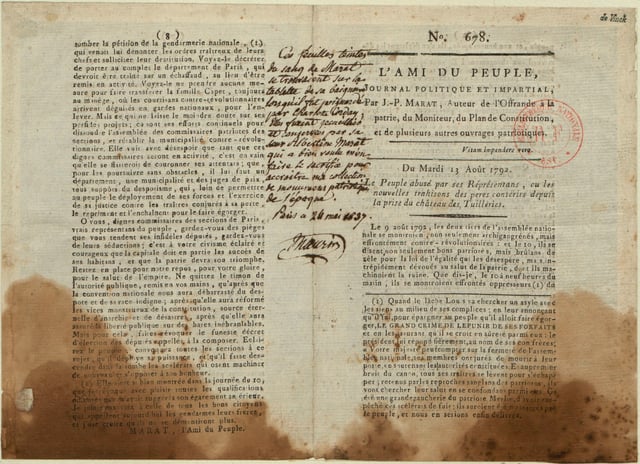
A copy of L'Ami du peuple stained with the blood of Marat
In the Old regime there were a small number of heavily censored newspapers that needed a royal licence to operate. Newspapers and pamphlets played a central role in stimulating and defining the Revolution. The meetings of the Estates-General in 1789 created an enormous demand for news, and over 130 newspapers appeared by the end of the year. Among the most significant of these newspapers in 1789 were Marat's L'Ami du peuple and Elysée Loustallot's Revolutions de Paris. The next decade saw 2,000 newspapers founded, with 500 in Paris alone. Most lasted only a matter of weeks. Together they became the main communication medium, combined with the very large pamphlet literature.[175] Newspapers were read aloud in taverns and clubs, and circulated hand to hand. The press saw its lofty role to be the advancement of civic republicanism based on public service, and downplayed the liberal, individualistic goal of making a profit.[176][177][178][179] By 1793 the radicals were most active but at the start the royalists flooded the country with their press the "Ami du Roi" (Friends of the King) until they were suppressed.[180] Napoleon only allowed four newspapers, all under tight control.
Symbolism
Symbolism was a device to distinguish the main features of the Revolution and ensure public identification and support. In order to effectively illustrate the differences between the new Republic and the old regime, the leaders needed to implement a new set of symbols to be celebrated instead of the old religious and monarchical symbolism. To this end, symbols were borrowed from historic cultures and redefined, while those of the old regime were either destroyed or reattributed acceptable characteristics. These revised symbols were used to instil in the public a new sense of tradition and reverence for the Enlightenment and the Republic.[181]
La Marseillaise
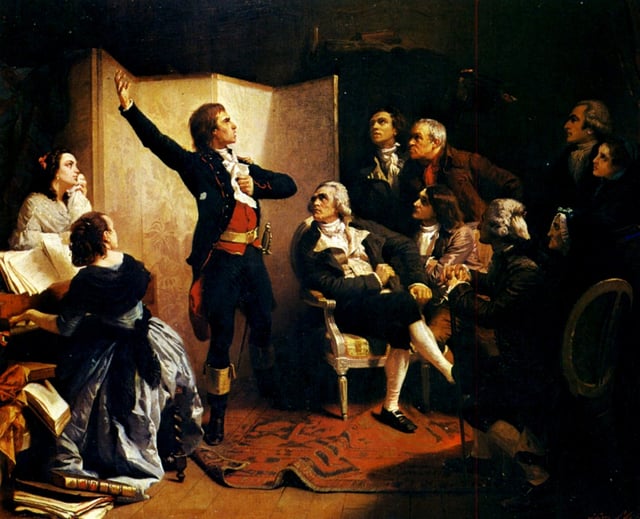
Rouget de Lisle, composer of the Marseillaise, sings it for the first time in 1792.
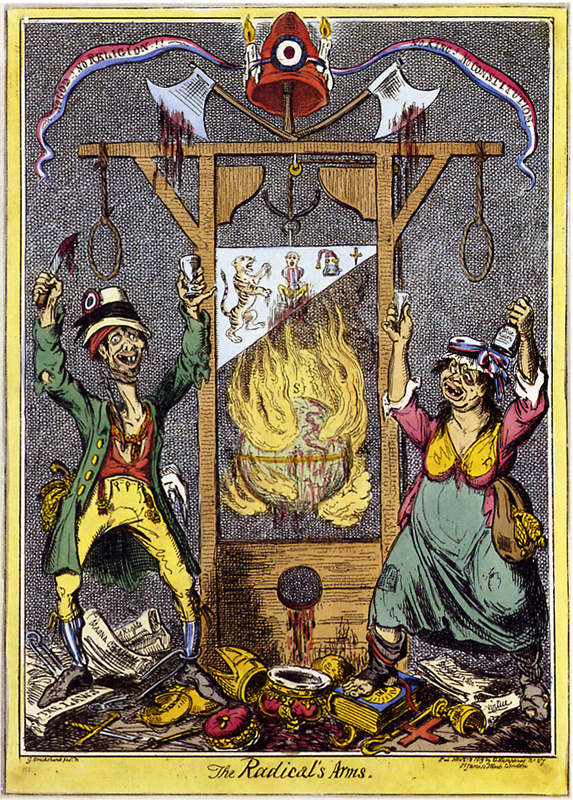
English cartoon attacking the excesses of the Revolution as symbolised by the guillotine; between 18,000 and 40,000 people were executed during the Reign of Terror.
"La Marseillaise" (French pronunciation: [la maʁsɛjɛːz]) became the national anthem of France. The song was written and composed in 1792 by Claude Joseph Rouget de Lisle, and was originally titled "Chant de guerre pour l'Armée du Rhin". The French National Convention adopted it as the First Republic's anthem in 1795. It acquired its nickname after being sung in Paris by volunteers from Marseille marching on the capital.
The song is the first example of the "European march" anthemic style. The anthem's evocative melody and lyrics have led to its widespread use as a song of revolution and its incorporation into many pieces of classical and popular music. Cerulo says, "the design of "La Marseillaise" is credited to General Strasburg of France, who is said to have directed de Lisle, the composer of the anthem, to 'produce one of those hymns which conveys to the soul of the people the enthusiasm which it (the music) suggests.'"[182]
Guillotine
Hanson notes, "The guillotine stands as the principal symbol of the Terror in the French Revolution."[183] Invented by a physician during the Revolution as a quicker, more efficient and more distinctive form of execution, the guillotine became a part of popular culture and historic memory. It was celebrated on the left as the people's avenger and cursed as the symbol of the Reign of Terror by the right.[184] Its operation became a popular entertainment that attracted great crowds of spectators. Vendors sold programmes listing the names of those scheduled to die. Many people came day after day and vied for the best locations from which to observe the proceedings; knitting women (tricoteuses) formed a cadre of hardcore regulars, inciting the crowd. Parents often brought their children. By the end of the Terror, the crowds had thinned drastically. Repetition had staled even this most grisly of entertainments, and audiences grew bored.[185]
What it is that horrifies people changes over time. Doyle comments:
- Even the unique horror of the guillotine has been dwarfed by the gas chambers of the Holocaust, the organized brutality of the gulag, the mass intimidation of Mao's cultural revolution, or the killing fields of Cambodia.[186]
Tricolore cockade

The tricolour cockade, created in July 1789. White was added to "nationalise" an earlier blue and red design.
Cockades were widely worn by revolutionaries beginning in 1789. They now pinned the blue-and-red cockade of Paris onto the white cockade of the Ancien Régime – thus producing the original Tricolore cockade. Later, distinctive colours and styles of cockade would indicate the wearer's faction – although the meanings of the various styles were not entirely consistent, and varied somewhat by region and period.
The tricolour flag is derived from the cockades used in the 1790s. These were circular rosette-like emblems attached to the hat. Camille Desmoulins asked his followers to wear green cockades on 12 July 1789. The Paris militia, formed on 13 July, adopted a blue and red cockade. Blue and red are the traditional colours of Paris, and they are used on the city's coat of arms. Cockades with various colour schemes were used during the storming of the Bastille on 14 July.[187] The blue and red cockade was presented to King Louis XVI at the Hôtel de Ville on 17 July. Lafayette argued for the addition of a white stripe to "nationalise" the design.[188] On 27 July, a tricolour cockade was adopted as part of the uniform of the National Guard, the national police force that succeeded the militia.[189]
Well after the revolution, by 1912 the French Third Republic had authorised the form of the tricolore cockade for use on its military aircraft by the Aeronautique Militaire as a national insignia,[190] the first-ever in use worldwide – it is still in use by the current Armee de l'Air of France, and directly inspired the use of similar roundel insignia by the United Kingdom and many other nations worldwide.
Fasces

The unofficial but common National Emblem of France is backed by a fasces, representing justice.
Fasces are Roman in origin and suggest Roman Republicanism. Fasces are a bundle of birch rods containing an axe. The French Republic continued this Roman symbol to represent state power, justice, and unity.[181]
Liberty cap
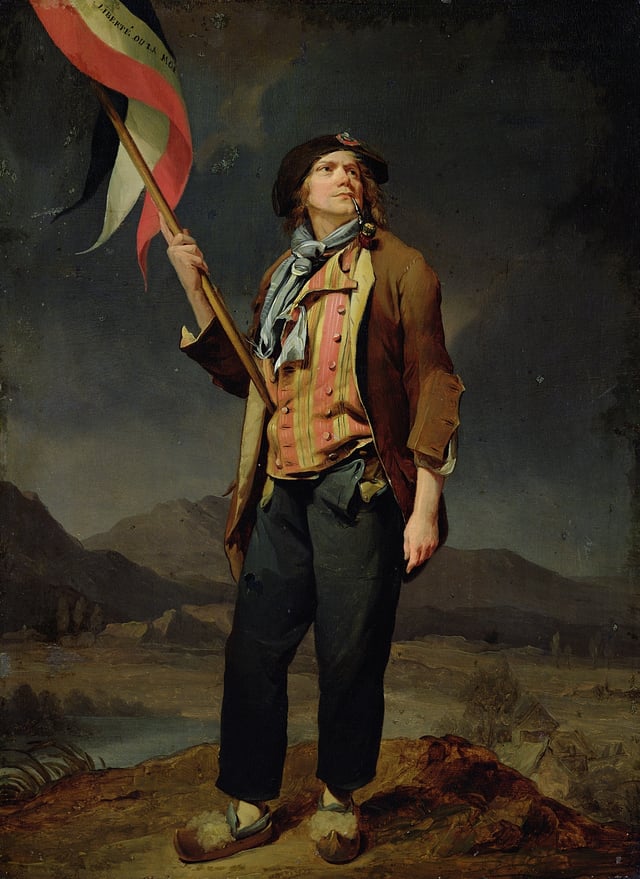
Early depiction of the tricolour in the hands of a sans-culotte
The Liberty cap, also known as the Phrygian cap, or pileus, is a brimless, felt cap that is conical in shape with the tip pulled forward. It reflects Roman republicanism and liberty, alluding to the Roman ritual of manumission of slaves, in which a freed slave receives the bonnet as a symbol of his newfound liberty.[191]
Role of women

Club of patriotic women in a church
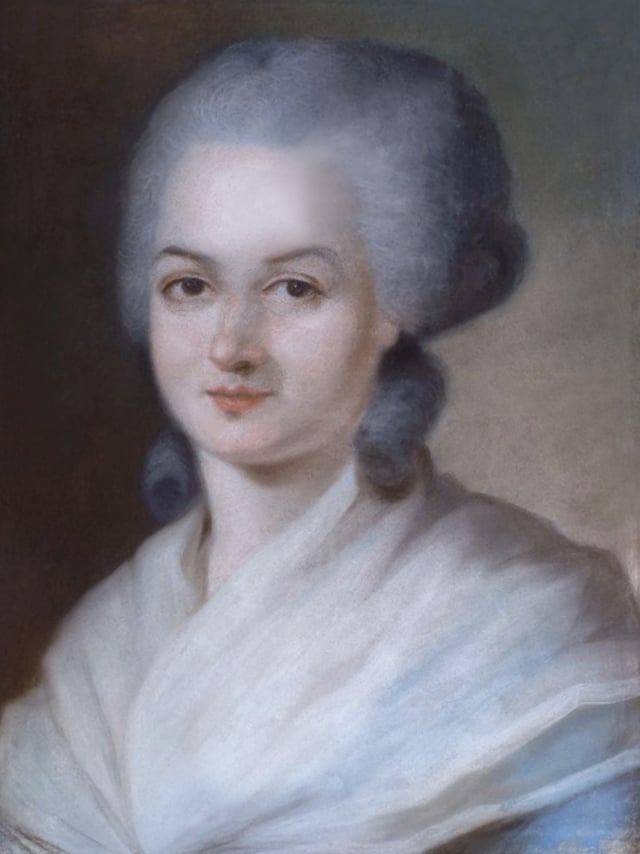
Olympe de Gouges was the author of the Declaration of the Rights of Woman and the Female Citizen in 1791.
Historians since the late 20th century have debated how women shared in the French Revolution and what long-term impact it had on French women. Women had no political rights in pre-Revolutionary France; they were considered "passive" citizens; forced to rely on men to determine what was best for them. That changed dramatically in theory as there seemingly were great advances in feminism. Feminism emerged in Paris as part of a broad demand for social and political reform. The women demanded equality for women and then moved on to a demand for the end of male domination. Their chief vehicle for agitation were pamphlets and women's clubs; for example, a small group called the Cercle Social (Social Circle) campaigned for women's rights, noting that "the laws favor men at the expense of women, because everywhere power is in your hands."[192] However, in October 1793, the country's all-male legislative body voted to ban all women's clubs. The movement was crushed. Devance explains the decision in terms of the emphasis on masculinity in a wartime situation, Marie Antoinette's bad reputation for feminine interference in state affairs, and traditional male supremacy.[193] A decade later the Napoleonic Code confirmed and perpetuated women's second-class status.[194]
When the Revolution opened, groups of women acted forcefully, making use of the volatile political climate. Women forced their way into the political sphere. They swore oaths of loyalty, "solemn declarations of patriotic allegiance, [and] affirmations of the political responsibilities of citizenship." De Corday d'Armont is a prime example of such a woman; engaged in the revolutionary political faction of the Girondins, she assassinated the Jacobin leader, Marat. Throughout the Revolution, other women such as Pauline Léon and her Society of Revolutionary Republican Women supported the radical Jacobins, staged demonstrations in the National Assembly and participated in the riots, often using armed force.[195]
The March to Versailles is but one example of feminist militant activism during the French Revolution. While largely left out of the thrust for increasing rights of citizens, as the question was left indeterminate in the Declaration of the Rights of Man,[196] activists such as Pauline Léon and Théroigne de Méricourt agitated for full citizenship for women.[197] Women were, nonetheless, "denied political rights of 'active citizenship' (1791) and democratic citizenship (1793)."[196]
On 20 June 1792 a number of armed women took part in a procession that "passed through the halls of the Legislative Assembly, into the Tuileries Gardens, and then through the King's residence."[198] Militant women also assumed a special role in the funeral of Marat, following his murder on 13 July 1793. As part of the funeral procession, they carried the bathtub in which Marat had been murdered (by a counter-revolutionary woman) as well as a shirt stained with Marat's blood.[199] On 20 May 1793 women were at the fore of a crowd that demanded "bread and the Constitution of 1793." When their cries went unnoticed, the women went on a rampage, "sacking shops, seizing grain and kidnapping officials."[200]
The Society of Revolutionary Republican Women, a militant group on the far left, demanded a law in 1793 that would compel all women to wear the tricolour cockade to demonstrate their loyalty to the Republic. They also demanded vigorous price controls to keep bread – the major food of the poor people – from becoming too expensive. After the Convention passage law in September 1793, the Revolutionary Republican Women demanded vigorous enforcement, but were counted by market women, former servants, and religious women who adamantly opposed price controls (which would drive them out of business ) and resented attacks on the aristocracy and on religion. Fist fights broke out in the streets between the two factions of women.
Meanwhile, the men who controlled the Jacobins rejected the Revolutionary Republican Women as dangerous rabble-rousers. At this point the Jacobins controlled the government; they dissolved the Society of Revolutionary Republican Women, and decreed that all women's clubs and associations were illegal. They sternly reminded women to stay home and tend to their families by leaving public affairs to the men. Organised women were permanently shut out of the French Revolution after 30 October 1793.[201]
Prominent women
Olympe de Gouges wrote a number of plays, short stories, and novels. Her publications emphasised that women and men are different, but this shouldn't stop them from equality under the law. In her "Declaration on the Rights of Woman" she insisted that women deserved rights, especially in areas concerning them directly, such as divorce and recognition of illegitimate children.[202]
Madame Roland (a.k.a. Manon or Marie Roland) was another important female activist. Her political focus was not specifically on women or their liberation. She focused on other aspects of the government, but was a feminist by virtue of the fact that she was a woman working to influence the world. Her personal letters to leaders of the Revolution influenced policy; in addition, she often hosted political gatherings of the Brissotins, a political group which allowed women to join. As she was led to the scaffold, Madame Roland shouted "O liberty! What crimes are committed in thy name!"[203]
Most of these activists were punished for their actions. Many of the women of the Revolution were even publicly executed for "conspiring against the unity and the indivisibility of the Republic".[204]
Counter-revolutionary women
A major aspect of the French Revolution was the dechristianisation movement, a movement strongly rejected by many devout people. Especially for women living in rural areas of France, the closing of the churches meant a loss of normalcy.[205]
When these revolutionary changes to the Church were implemented, it sparked a counter-revolutionary movement among women. Although some of these women embraced the political and social amendments of the Revolution, they opposed the dissolution of the Catholic Church and the formation of revolutionary cults like the Cult of the Supreme Being.[206] As Olwen Hufton argues, these women began to see themselves as the "defenders of faith".[207] They took it upon themselves to protect the Church from what they saw as a heretical change to their faith, enforced by revolutionaries.
Counter-revolutionary women resisted what they saw as the intrusion of the state into their lives.[208] Economically, many peasant women refused to sell their goods for assignats because this form of currency was unstable and was backed by the sale of confiscated Church property. By far the most important issue to counter-revolutionary women was the passage and the enforcement of the Civil Constitution of the Clergy in 1790. In response to this measure, women in many areas began circulating anti-oath pamphlets and refused to attend masses held by priests who had sworn oaths of loyalty to the Republic. These women continued to adhere to traditional practices such as Christian burials and naming their children after saints in spite of revolutionary decrees to the contrary.[209]
Economic policies

Early Assignat of 29 September 1790: 500 livres

The value of Assignats (1789–96)
The French Revolution abolished many of the constraints on the economy that had slowed growth during the ancien regime. It abolished tithes owed to local churches as well as feudal dues owed to local landlords. The result hurt the tenants, who paid both higher rents and higher taxes.[210] It nationalised all church lands, as well as lands belonging to royalist enemies who went into exile. It planned to use these seized lands to finance the government by issuing assignats. It abolished the guild system as a worthless remnant of feudalism.[211] It also abolished the highly inefficient system of tax farming, whereby private individuals would collect taxes for a hefty fee. The government seized the foundations that had been set up (starting in the 13th century) to provide an annual stream of revenue for hospitals, poor relief, and education. The state sold the lands but typically local authorities did not replace the funding and so most of the nation's charitable and school systems were massively disrupted.[212]
The economy did poorly in 1790–96 as industrial and agricultural output dropped, foreign trade plunged, and prices soared. The government decided not to repudiate the old debts. Instead it issued more and more paper money (called "assignat") that supposedly were grounded seized lands. The result was escalating inflation. The government imposed price controls and persecuted speculators and traders in the black market. People increasingly refused to pay taxes as the annual government deficit increased from 10% of gross national product in 1789 to 64% in 1793. By 1795, after the bad harvest of 1794 and the removal of price controls, inflation had reached a level of 3500%. The assignats were withdrawn in 1796 but the replacements also fuelled inflation. The inflation was finally ended by Napoleon in 1803 with the franc as the new currency.[213]
Napoleon after 1799 paid for his expensive wars by multiple means, starting with the modernisation of the rickety financial system.[214] He conscripted soldiers at low wages, raised taxes, placed large-scale loans, sold lands formerly owned by the Catholic Church, sold Louisiana to the United States, plundered conquered areas and seized food supplies, and levied requisitions on countries he controlled, such as Italy.[215]
Long-term impact
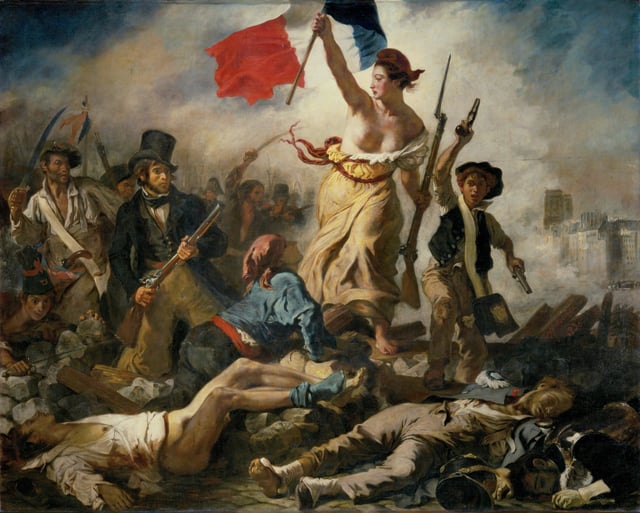
La Liberté guidant le peuple, painting by Eugène Delacroix commemorating the July Revolution of 1830
Otto Dann and John Dinwiddy report, "It has long been almost a truism of European history that the French Revolution gave a great stimulus to the growth of modern nationalism."[218] Nationalism was emphasised by historian Carlton J.H. Hayes as a major result of the French Revolution across Europe. The impact on French nationalism was profound. For example, Napoleon became such a heroic symbol of the nation that the glory was easily picked up by his nephew, who was overwhelmingly elected president (and later became Emperor Napoleon III).[219] The influence was great in the hundreds of small German states and elsewhere, where it was either inspired by the French example or in reaction against it.[220][221]
France
The changes in France were enormous; some were widely accepted and others were bitterly contested into the late 20th century.[222] Before the Revolution, the people had little power or voice. The kings had so thoroughly centralised the system that most nobles spent their time at Versailles, and thus played only a small direct role in their home districts. Thompson says that the kings had "ruled by virtue of their personal wealth, their patronage of the nobility, their disposal of ecclesiastical offices, their provincial governors (intendants) their control over the judges and magistrates, and their command of the Army."[223]
After the first year of revolution, the power of the king had been stripped away, he was left a mere figurehead, the nobility had lost all their titles and most of their land, the Church lost its monasteries and farmlands, bishops, judges and magistrates were elected by the people, and the army was almost helpless, with military power in the hands of the new revolutionary National Guard. The central elements of 1789 were the slogan "Liberty, Equality and Fraternity" and "The Declaration of the Rights of Man and the Citizen", which Lefebvre calls "the incarnation of the Revolution as a whole."[224]
The long-term impact on France was profound, shaping politics, society, religion and ideas, and polarising politics for more than a century. Historian François Aulard writes:
"From the social point of view, the Revolution consisted in the suppression of what was called the feudal system, in the emancipation of the individual, in greater division of landed property, the abolition of the privileges of noble birth, the establishment of equality, the simplification of life.... The French Revolution differed from other revolutions in being not merely national, for it aimed at benefiting all humanity."[225]
Religion and charity
The most heated controversy was over the status of the Catholic Church.[226] From a dominant position in 1788, it was almost destroyed in less than a decade, its priests and nuns turned out, its leaders dead or in exile, its property controlled by its enemies, and a strong effort underway to remove all influence of Christian religiosity, such as Sundays, holy days, saints, prayers, rituals and ceremonies. The movement to dechristianise France not only failed but aroused a furious reaction among the pious.[227][228] Napoleon's Concordat was a compromise that restored some of the Catholic Church's traditional roles but not its power, its lands or its monasteries. Priests and bishops were given salaries as part of a department of government controlled by Paris, not Rome. Protestants and Jews gained equal rights.[229] Battles over the role of religion in the public sphere, and closely related issues such as church-controlled schools, that were opened by the Revolution have never seen closure. They raged into the 20th century. By the 21st century, angry debates exploded over the presence of any Muslim religious symbols in schools, such as the headscarves for which Muslim girls could be expelled. J. Christopher Soper and Joel S. Fetzer explicitly link the conflict over religious symbols in public to the French Revolution, when the target was Catholic rituals and symbols.[230]
The revolutionary government seized the charitable foundations that had been set up (starting in the 13th century) to provide an annual stream of revenue for hospitals, poor relief, and education. The state sold the lands but typically local authorities did not replace the funding and so most of the nation's charitable and school systems were massively disrupted.[212]
In the ancien regime, new opportunities for nuns as charitable practitioners were created by devout nobles on their own estates. The nuns provided comprehensive care for the sick poor on their patrons' estates, not only acting as nurses, but taking on expanded roles as physicians, surgeons, and apothecaries. During the Revolution, most of the orders of nuns were shut down and there was no organised nursing care to replace them.[231] However, the demand for their nursing services remained strong, and after 1800 the sisters reappeared and resumed their work in hospitals and on rural estates. They were tolerated by officials because they had widespread support and were the link between elite male physicians and distrustful peasants who needed help.[232]
Economics
Two thirds of France was employed in agriculture, which was transformed by the Revolution. With the breakup of large estates controlled by the Church and the nobility and worked by hired hands, rural France became more a land of small independent farms. Harvest taxes were ended, such as the tithe and seigneurial dues, much to the relief of the peasants. Primogeniture was ended both for nobles and peasants, thereby weakening the family patriarch. Because all the children had a share in the family's property, there was a declining birth rate.[233][234] Cobban says the revolution bequeathed to the nation "a ruling class of landowners."[235]
In the cities, entrepreneurship on a small scale flourished, as restrictive monopolies, privileges, barriers, rules, taxes and guilds gave way. However, the British blockade virtually ended overseas and colonial trade, hurting the port cities and their supply chains. Overall, the Revolution did not greatly change the French business system, and probably helped freeze in place the horizons of the small business owner. The typical businessman owned a small store, mill or shop, with family help and a few paid employees; large-scale industry was less common than in other industrialising nations.[236]
A 2017 National Bureau of Economic Research paper found that the emigration of more than 100,000 individuals (predominantly supporters of the Old Regime) during the Revolution had a significant negative impact on income per capita in the 19th century (due to the fragmentation of agricultural holdings) but became positive in the second half of the 20th century onward (because it facilitated the rise in human capital investments).[237] Another 2017 paper found that the redistribution of land had a positive impact on agricultural productivity, but that these gains gradually declined over the course of the 19th century.[238][239]
Constitutionalism
The Revolution meant an end to arbitrary royal rule and held out the promise of rule by law under a constitutional order, but it did not rule out a monarch. Napoleon as emperor set up a constitutional system (although he remained in full control), and the restored Bourbons were forced to go along with one. After the abdication of Napoleon III in 1871, the monarchists probably had a voting majority, but they were so factionalised they could not agree on who should be king, and instead the French Third Republic was launched with a deep commitment to upholding the ideals of the Revolution.[240][241] The conservative Catholic enemies of the Revolution came to power in Vichy France (1940–44), and tried with little success to undo its heritage, but they kept it a republic. Vichy denied the principle of equality and tried to replace the Revolutionary watchwords "Liberty, Equality, Fraternity" with "Work, Family, and Fatherland." However, there were no efforts by the Bourbons, Vichy or anyone else to restore the privileges that had been stripped away from the nobility in 1789. France permanently became a society of equals under the law.[242]
Communism
The Jacobin cause was picked up by Marxists in the mid-19th century and became an element of communist thought around the world. In the Soviet Union, "Gracchus" Babeuf was regarded as a hero.[243]
Outside France
Economic historians Dan Bogart, Mauricio Drelichman, Oscar Gelderblom, and Jean-Laurent Rosenthal described codified law as the French Revolution's "most significant export." They wrote, "While restoration returned most of their power to the absolute monarchs who had been deposed by Napoleon, only the most recalcitrant ones, such as Ferdinand VII of Spain, went to the trouble of completely reversing the legal innovations brought on by the French."[244] They also note that the French Revolution and the Napoleonic Wars caused England, Spain, Prussia and the Dutch Republic to centralize their fiscal systems to an unprecedented extent in order to finance the military campaigns of the Napoleonic Wars.[244]
According to Daron Acemoglu, Davide Cantoni, Simon Johnson, and James A. Robinson the French Revolution had long-term effects in Europe. They suggest that "areas that were occupied by the French and that underwent radical institutional reform experienced more rapid urbanization and economic growth, especially after 1850. There is no evidence of a negative effect of French invasion."[245]
A 2016 study in the European Economic Review found that the areas of Germany that were occupied by France in the 19th century and in which the Code Napoleon was applied have higher levels of trust and cooperation today.[246]
Britain
On 16 July 1789, two days after the Storming of the Bastille, John Frederick Sackville, serving as ambassador to France, reported to Secretary of State for Foreign Affairs Francis Osborne, 5th Duke of Leeds, "Thus, my Lord, the greatest revolution that we know anything of has been effected with, comparatively speaking – if the magnitude of the event is considered – the loss of very few lives. From this moment we may consider France as a free country, the King a very limited monarch, and the nobility as reduced to a level with the rest of the nation.[247]" Yet Britain saw minority support while the majority, and especially the among aristocracy, strongly opposed the French Revolution. Britain led and funded the series of coalitions that fought France from 1793 to 1815, and then restored the Bourbons.
Philosophically and politically, Britain was in debate over the rights and wrongs of revolution, in the abstract and in practicalities. The Revolution Controversy was a "pamphlet war" set off by the publication of A Discourse on the Love of Our Country, a speech given by Richard Price to the Revolution Society on 4 November 1789, supporting the French Revolution (as he had the American Revolution), and saying that patriotism actually centers around loving the people and principles of a nation, not its ruling class. Edmund Burke responded in November 1790 with his own pamphlet, Reflections on the Revolution in France, attacking the French Revolution as a threat to the aristocracy of all countries.[248][249] William Coxe opposed Price's premise that one's country is principles and people, not the State itself.[250]
Conversely, two seminal political pieces of political history were written in Price's favor, supporting the general right of the French people to replace their State. One of the first of these "pamphlets" into print was A Vindication of the Rights of Men by Mary Wollstonecraft (better known for her later treatise, sometimes described as the first feminist text, A Vindication of the Rights of Woman); Wollstonecraft's title was echoed by Thomas Paine's Rights of Man, published a few months later. In 1792 Christopher Wyvill published Defence of Dr. Price and the Reformers of England, a plea for reform and moderation.[251]
In Ireland, the effect was to transform what had been an attempt by Protestant settlers to gain some autonomy into a mass movement led by the Society of United Irishmen involving Catholics and Protestants. It stimulated the demand for further reform throughout Ireland, especially in Ulster. The upshot was a revolt in 1798, led by Wolfe Tone, that was crushed by Britain.[254]
Germany
German reaction to the Revolution swung from favourable to antagonistic. At first it brought liberal and democratic ideas, the end of gilds, serfdom and the Jewish ghetto. It brought economic freedoms and agrarian and legal reform. Above all the antagonism helped stimulate and shape German nationalism.[255]
Switzerland
Belgium
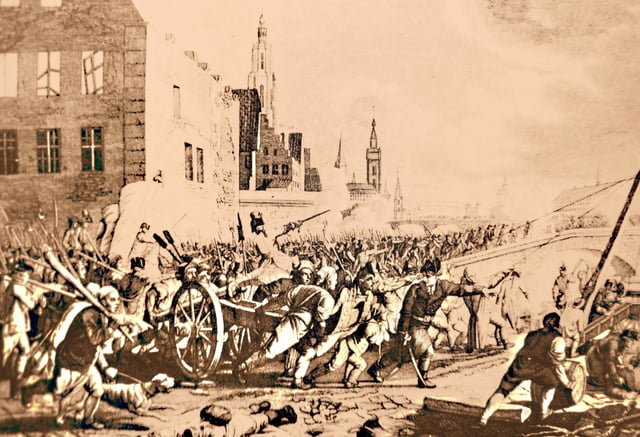
The Brabant Revolution broke out in the Austrian Netherlands in October 1789, inspired by the revolution in neighbouring France, but had collapsed by the end of 1790.
The region of modern-day Belgium was divided between two polities: the Austrian Netherlands and Prince-Bishopric of Liège. Both territories experienced revolutions in 1789. In the Austrian Netherlands, the Brabant Revolution succeeded in expelling Austrian forces and established the new United Belgian States. The Liège Revolution expelled the tyrannical Prince-Bishop and installed a republic. Both failed to attract international support. By December 1790, the Brabant revolution had been crushed and Liège was subdued the following year.
During the Revolutionary Wars, the French invaded and occupied the region between 1794 and 1814, a time known as the French period. The new government enforced new reforms, incorporating the region into France itself. New rulers were sent in by Paris. Belgian men were drafted into the French wars and heavily taxed. Nearly everyone was Catholic, but the Church was repressed. Resistance was strong in every sector, as Belgian nationalism emerged to oppose French rule. The French legal system, however, was adopted, with its equal legal rights, and abolition of class distinctions. Belgium now had a government bureaucracy selected by merit.[258]
Antwerp regained access to the sea and grew quickly as a major port and business centre. France promoted commerce and capitalism, paving the way for the ascent of the bourgeoisie and the rapid growth of manufacturing and mining. In economics, therefore, the nobility declined while the middle class Belgian entrepreneurs flourished because of their inclusion in a large market, paving the way for Belgium's leadership role after 1815 in the Industrial Revolution on the Continent.[259][260]
Scandinavia
The Kingdom of Denmark adopted liberalising reforms in line with those of the French Revolution, with no direct contact. Reform was gradual and the regime itself carried out agrarian reforms that had the effect of weakening absolutism by creating a class of independent peasant freeholders. Much of the initiative came from well-organised liberals who directed political change in the first half of the 19th century.[261]
United States
The Revolution deeply polarised American politics, and this polarisation led to the creation of the First Party System. In 1793, as war broke out in Europe, the Republican Party led by Thomas Jefferson favoured France and pointed to the 1778 treaty that was still in effect. George Washington and his unanimous cabinet, including Jefferson, decided that the treaty did not bind the United States to enter the war. Washington proclaimed neutrality instead.[262] Under President John Adams, a Federalist, an undeclared naval war took place with France from 1798 until 1799, often called the "Quasi War". Jefferson became president in 1801, but was hostile to Napoleon as a dictator and emperor. However, the two entered negotiations over the Louisiana Territory and agreed to the Louisiana Purchase in 1803, an acquisition that substantially increased the size of the United States.
Historiography
The French Revolution has received enormous amounts of historical attention, both from the general public and from scholars and academics. The views of historians, in particular, have been characterised as falling along ideological lines, with disagreement over the significance and the major developments of the Revolution.[263] Alexis de Tocqueville argued that the Revolution was a manifestation of a more prosperous middle class becoming conscious of its social importance.[264]
Other thinkers, like the conservative Edmund Burke, maintained that the Revolution was the product of a few conspiratorial individuals who brainwashed the masses into subverting the old order – a claim rooted in the belief that the revolutionaries had no legitimate complaints.[265] Other historians, influenced by Marxist thinking, have emphasised the importance of the peasants and the urban workers in presenting the Revolution as a gigantic class struggle.[266] In general, scholarship on the French Revolution initially studied the political ideas and developments of the era, but it has gradually shifted towards social history that analyses the impact of the Revolution on individual lives.[267]
Historians until the late 20th century emphasised class conflicts from a largely Marxist perspective as the fundamental driving cause of the Revolution.[268] The central theme of this argument was that the Revolution emerged from the rising bourgeoisie, with support from the sans-culottes, who fought to destroy the aristocracy.[269] However, Western scholars largely abandoned Marxist interpretations in the 1990s. By the year 2000 many historians were saying that the field of the French Revolution was in intellectual disarray. The old model or paradigm focusing on class conflict has been discredited, and no new explanatory model had gained widespread support.[270][271] Nevertheless, as Spang has shown, there persists a very widespread agreement to the effect that the French Revolution was the watershed between the premodern and modern eras of Western history.[270]
Historians widely regard the Revolution as one of the most important events in history. It marks the end of the early modern period, which started around 1500 and is often seen as marking the "dawn of the modern era".[272] Within France itself, the Revolution permanently crippled the power of the aristocracy and drained the wealth of the Church, although the two institutions survived despite the damage they sustained. After the collapse of the First Empire in 1815, the French public lost the rights and privileges earned since the Revolution, but they remembered the participatory politics that characterised the period, with one historian commenting: "Thousands of men and even many women gained firsthand experience in the political arena: they talked, read, and listened in new ways; they voted; they joined new organisations; and they marched for their political goals. Revolution became a tradition, and republicanism an enduring option."[273]
Some historians argue that the French people underwent a fundamental transformation in self-identity, evidenced by the elimination of privileges and their replacement by rights as well as the growing decline in social deference that highlighted the principle of equality throughout the Revolution.[274] The Revolution represented the most significant and dramatic challenge to political absolutism up to that point in history and spread democratic ideals throughout Europe and ultimately the world.[275] Throughout the 19th century, the revolution was heavily analysed by economists and political scientists, who saw the class nature of the revolution as a fundamental aspect in understanding human social evolution itself. This, combined with the egalitarian values introduced by the revolution, gave rise to a classless and co-operative model for society called "socialism" which profoundly influenced future revolutions in France and around the world.
See also
Age of Revolution
Timeline of the French Revolution
Glossary of the French Revolution for definitions of technical terms
List of people associated with the French Revolution
History of France
Paris in the 18th Century
Musée de la Révolution française
Political groups during the French Revolution
Jacobins
Cordeliers
Feuillants
Society of the Friends of Truth
Montagnards
Girondins